External links now open in a new browser tab - turn this off in your UCP - Read more here.
535is Homebrew Turbo (ex 633 Callaway) - 2024 Update
Re: 633CSi Callaway Turbo - 6/5/2017 - More Megasquirt Tunin
I am not sure what is going on with the car. I went to start it up today and it was especially long to crank. I had to give it gas to get it started and keep it running (not sure if was flood clear mode or not) and immediately blue smoke came out of the tailpipe and it felt like it was missing.
I pulls spark plugs and found #4 full coated and oil fouled. #3 looks fouled but I couldn't tell if it was oil or not. Residue did come off on my hand.
After reading the Bentley, excessive oil consumption points to Failed headgasket, worn valve guides, or leaking valve stem seal.
There is not a lot of vacuum when pulling the valve cover at idle, but no excess pressure like I had before, nor any milkshake coloring. Coolant level seems the same as well...
Oil in the combustion chamber is mystifying me.Thoughts?
I pulls spark plugs and found #4 full coated and oil fouled. #3 looks fouled but I couldn't tell if it was oil or not. Residue did come off on my hand.
After reading the Bentley, excessive oil consumption points to Failed headgasket, worn valve guides, or leaking valve stem seal.
There is not a lot of vacuum when pulling the valve cover at idle, but no excess pressure like I had before, nor any milkshake coloring. Coolant level seems the same as well...
Oil in the combustion chamber is mystifying me.Thoughts?
Re: 633CSi Callaway Turbo - 6/5/2017 - More Megasquirt Tunin
Sounds like leaky valve stem seals.
Re: 633CSi Callaway Turbo - 6/5/2017 - More Megasquirt Tunin
Last night I had a chance to pull it into the garage and start pulling it apart. Symptoms include really hard start, sputters and doesn't want to rev, and then won't idle (wants to die). Additionally, lots of blue smoke out the back when revving.
No oil in the intake piping and no pools in the downpipe, so I am pretty sure the turbo seals and drain are fine.
With the turbo off, I found cylinder #4 having evidence of oil leaking near the exhaust manifold gasket. Once the turbo was off, I found a small pool of oil in the exhaust port. I suspect the valve guide or valve stem seal failed. I have a new headgasket and hope to have the head off tonight. along with a few photos.
I have a spare head on my work bench ready to go in, it has a slightly better cam, but there is some corrosion on parts of the headgasket of the mating face. I'm trying to deice if I want to just try slapping it on or doing something else. Pictures tonight or tomorrow most likely.
No oil in the intake piping and no pools in the downpipe, so I am pretty sure the turbo seals and drain are fine.
With the turbo off, I found cylinder #4 having evidence of oil leaking near the exhaust manifold gasket. Once the turbo was off, I found a small pool of oil in the exhaust port. I suspect the valve guide or valve stem seal failed. I have a new headgasket and hope to have the head off tonight. along with a few photos.
I have a spare head on my work bench ready to go in, it has a slightly better cam, but there is some corrosion on parts of the headgasket of the mating face. I'm trying to deice if I want to just try slapping it on or doing something else. Pictures tonight or tomorrow most likely.
Re: 633CSi Callaway Turbo - 11/14/17 Engine Opened Up
From last night:
The oil stain coming from CYL #4
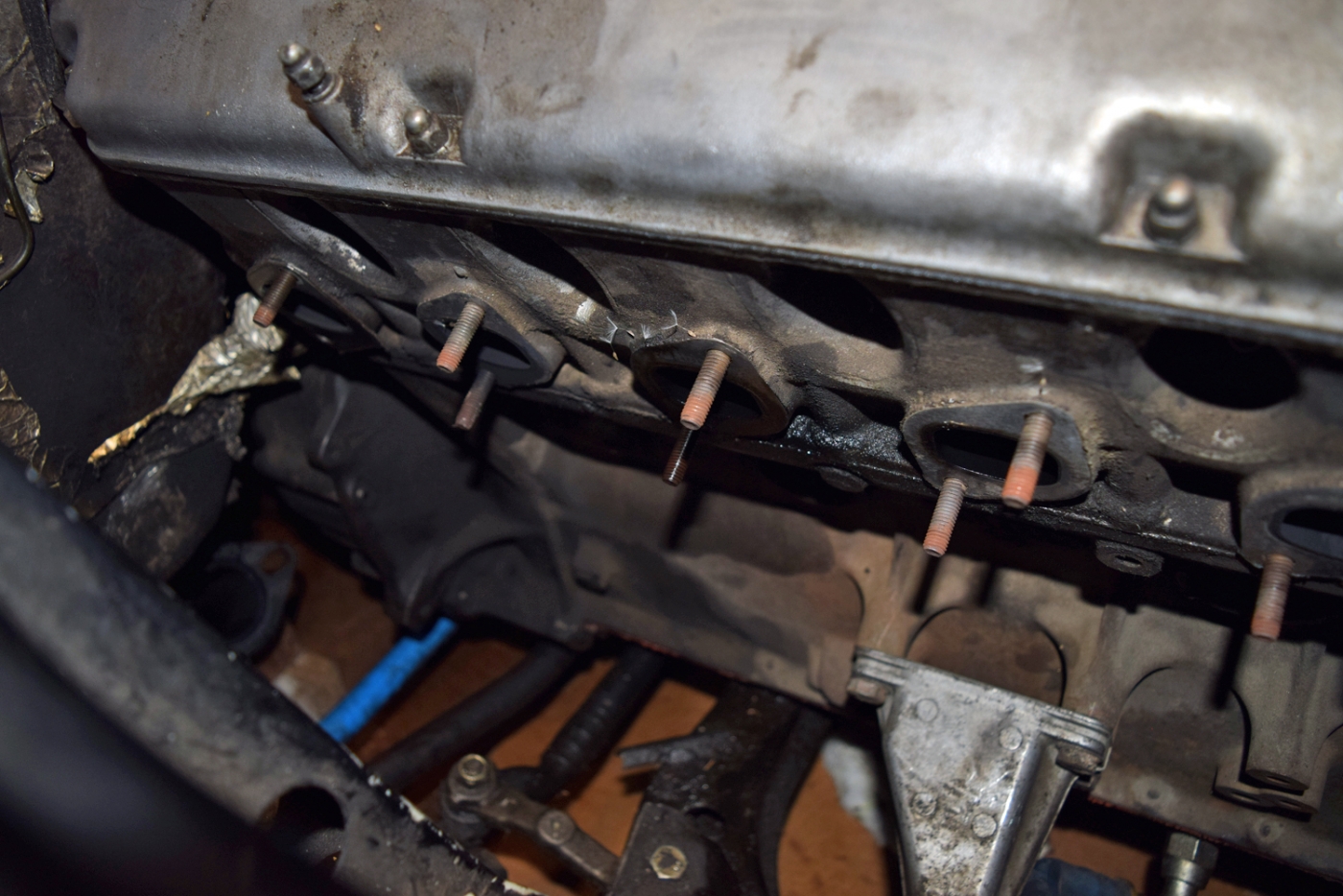
on the tubo manifold:
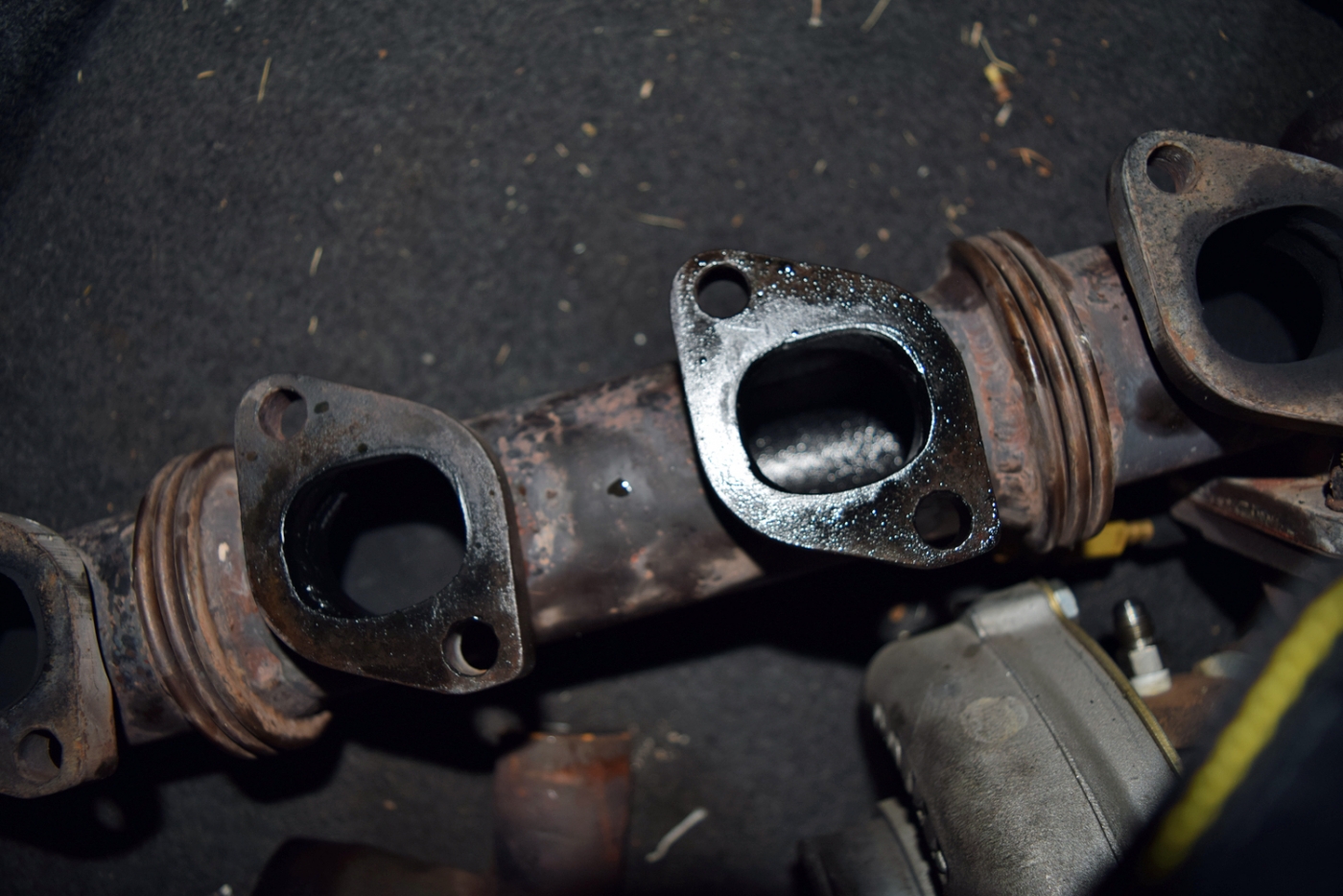
Some new tonight when taking the head off-- I wasn't expecting this! Cyl 2-4 were leaking to each other which explains why it wouldn't start or run very easily. Any ideas as to what caused the failure?
The engine seemed less strong than the one I had pulled out with the ring issue. I suspect these were partially damaged prior to me running it, but there's no way to know for sure. I had been careful to avoid detonation but had been tuning when engine started smoking badly.
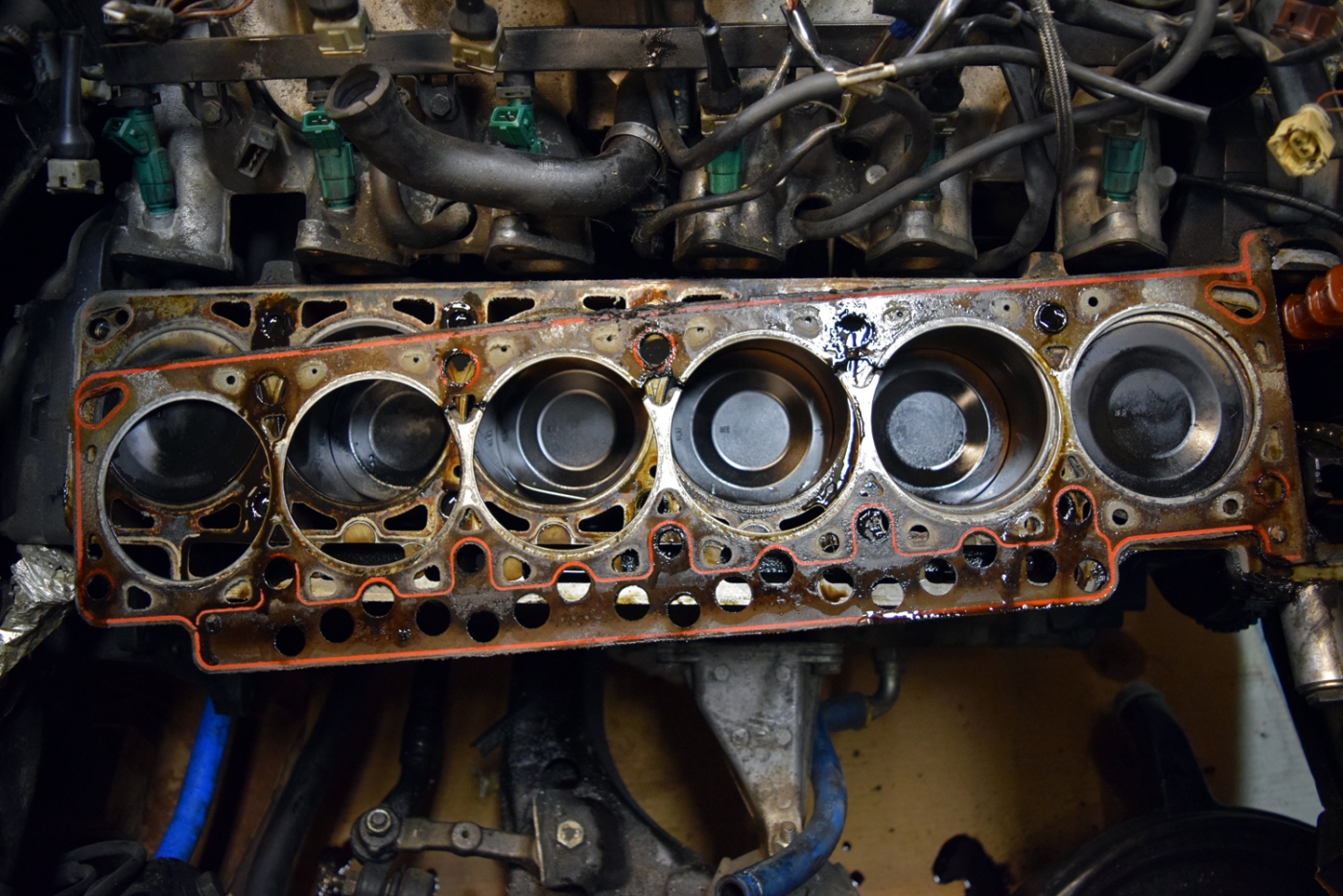
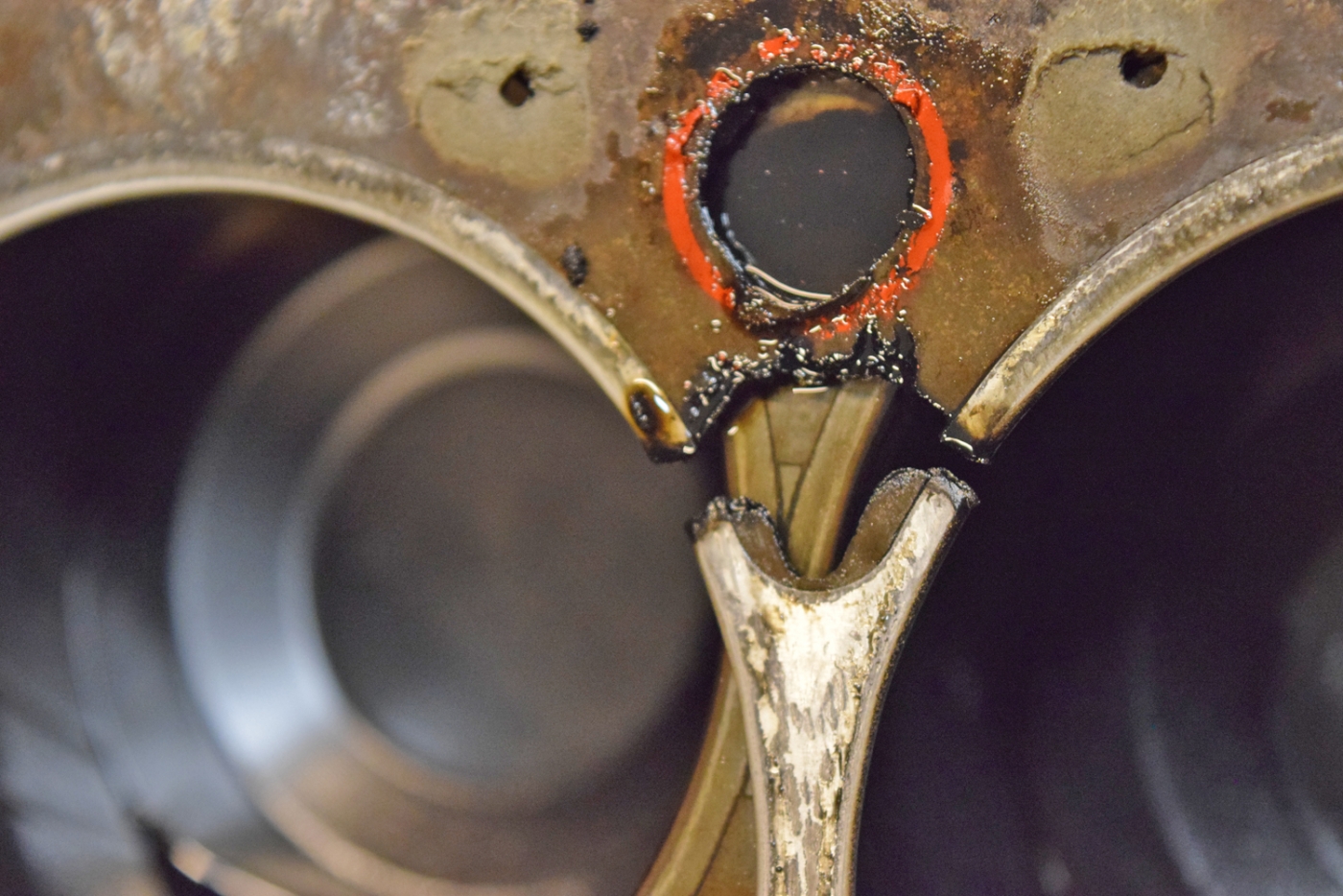
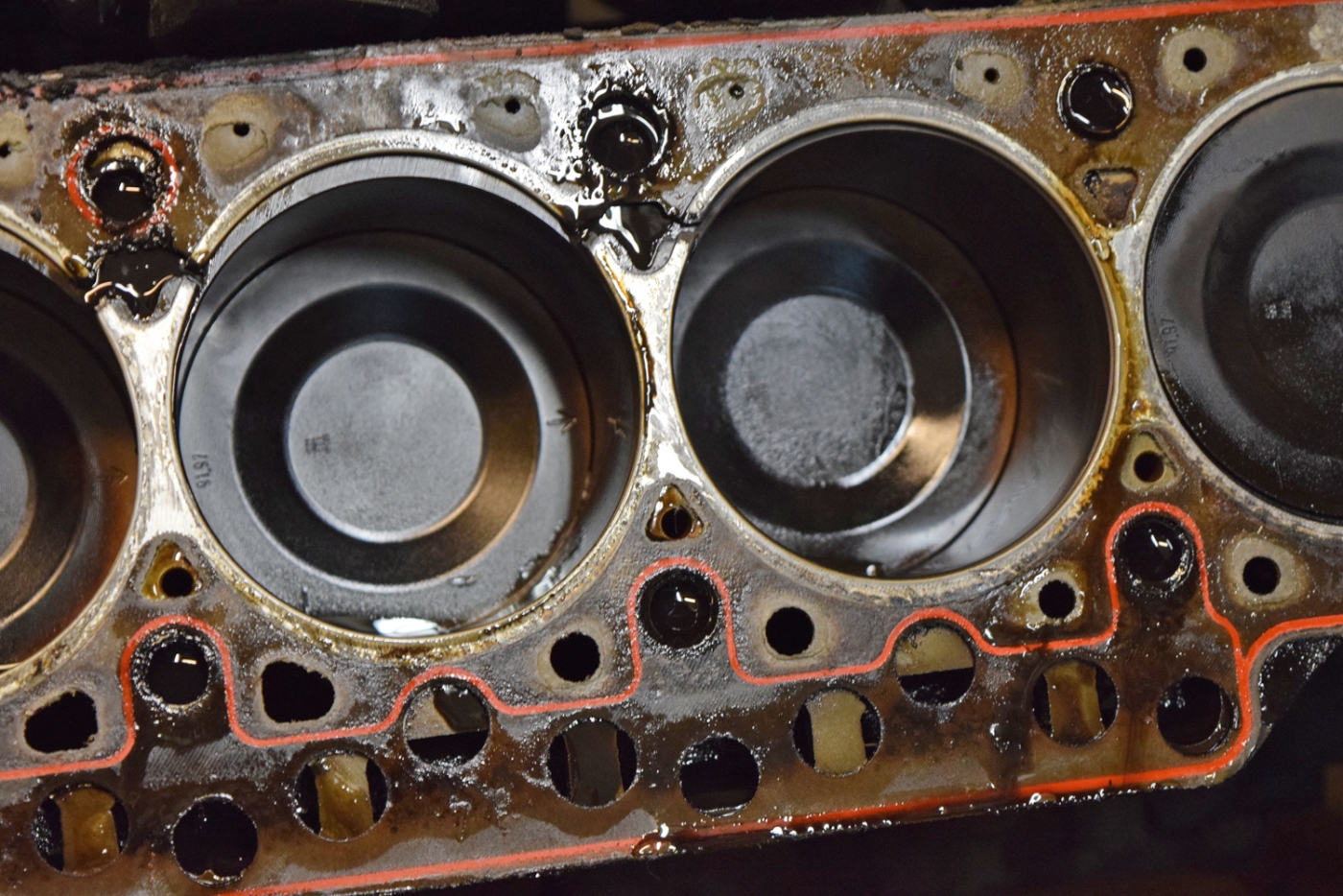
The head as it came off:
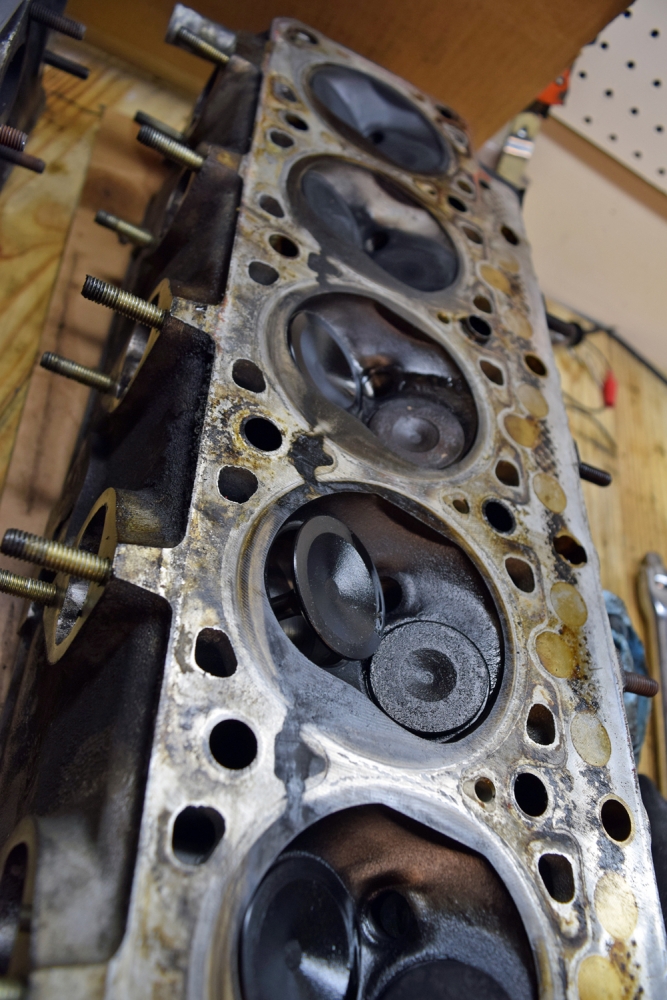
Some cleaning:
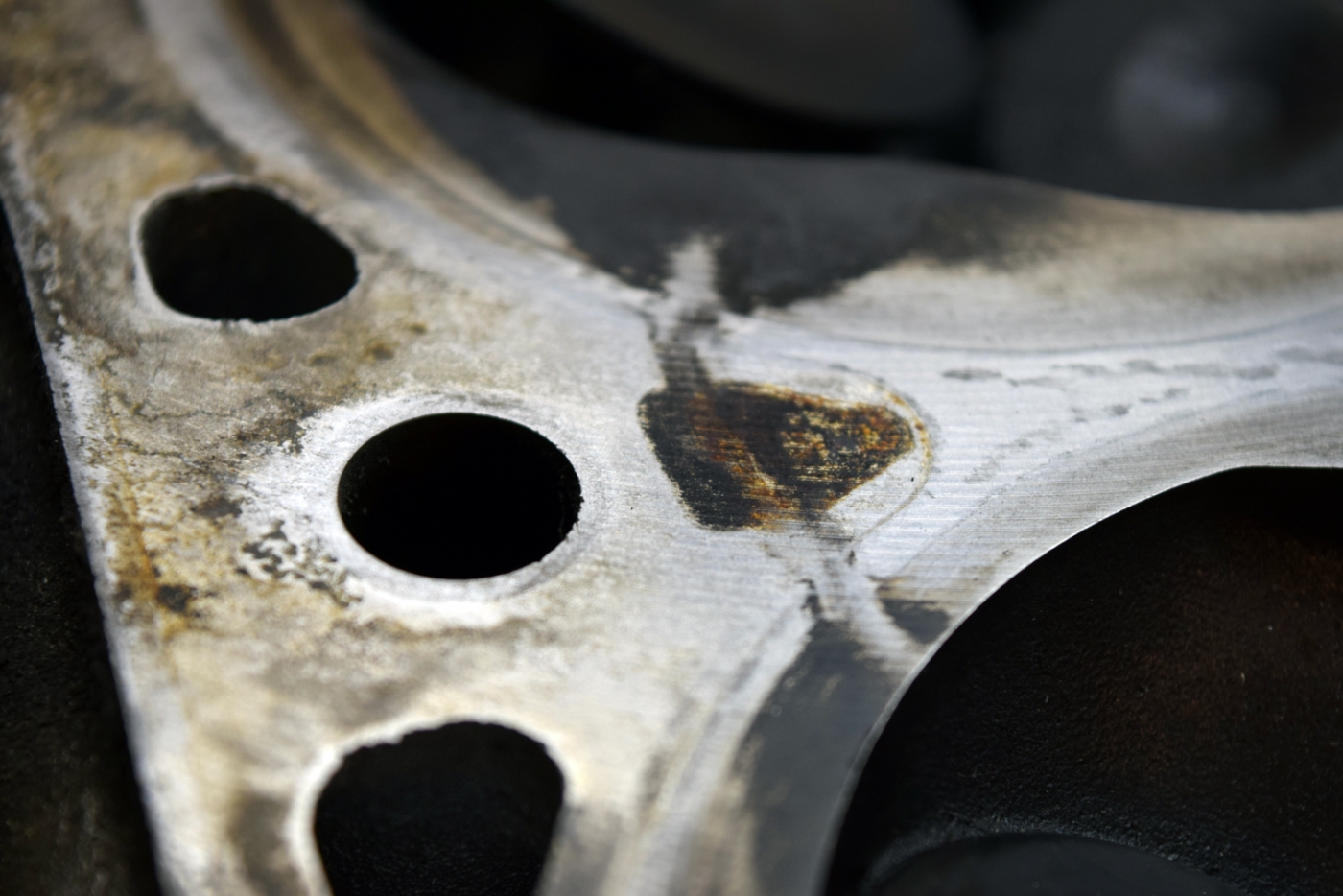
Some strange scratching on the edge of cyl #2:
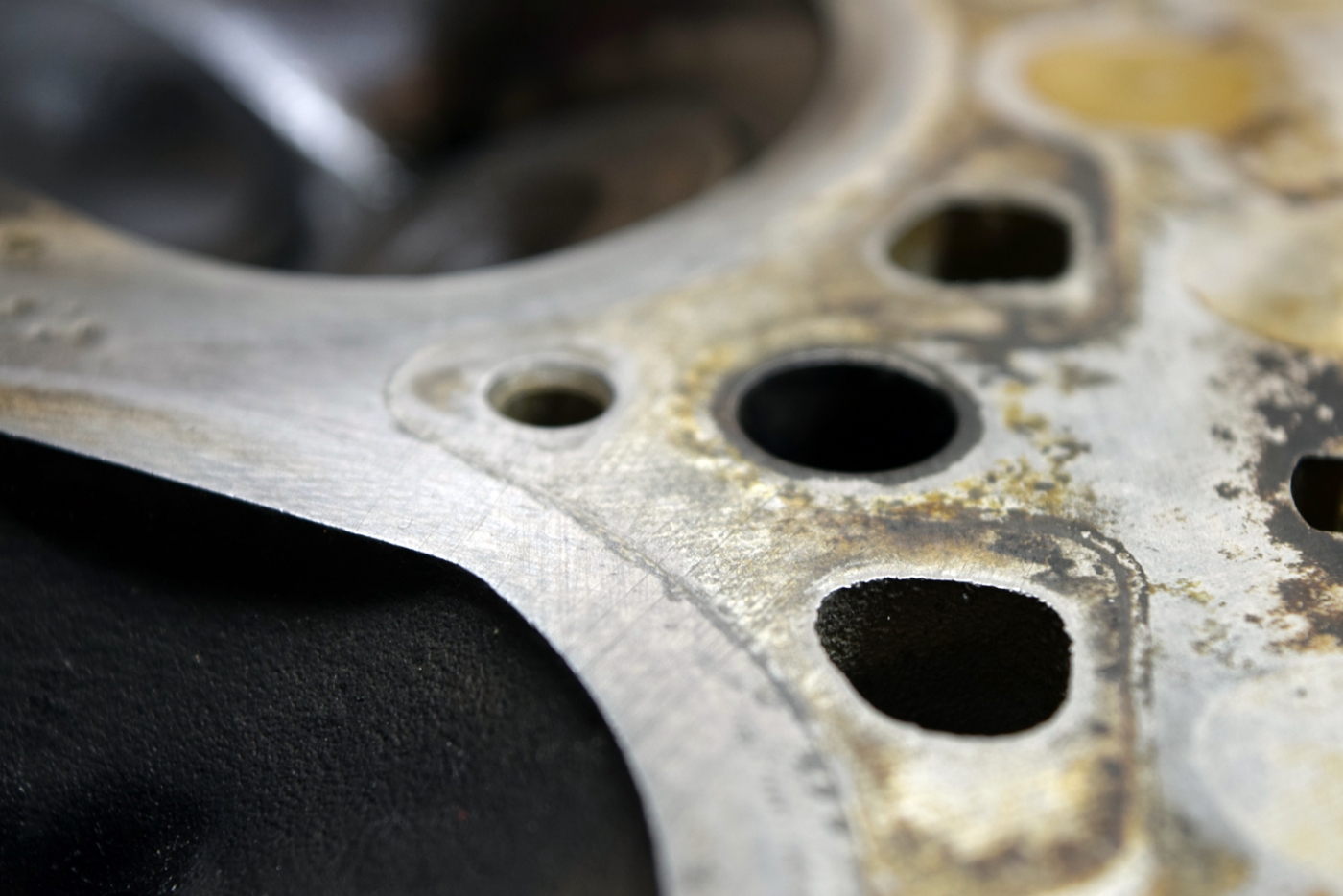
I'm not sure the cause but I believe it may have been partially damaged as It was installed... I'm not sure. I didn't replace the HG when I swapped engines.
I was thinking the oil burning was caused by failed valve stem seals-- obviously it wasn't. I had previously pulled my spare head but was upset to find this near cylinder #6. I think it needs reworked and I'm not going to reinstall it after all.
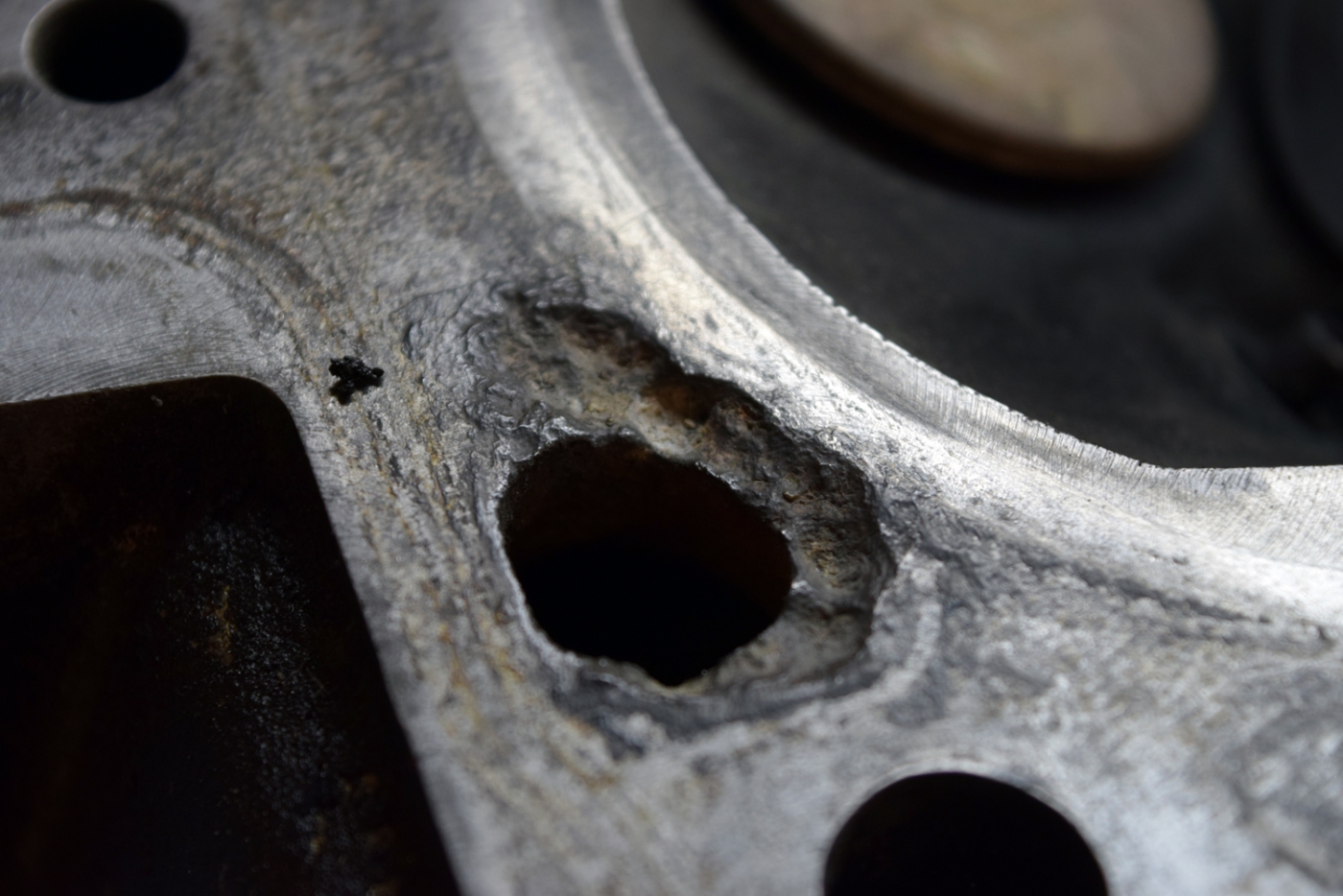
I have a new elring gasket, I just need to decide how much to really clean up the mating surfaces. I had just done this on my euro 635, but that was with a freshly machined head.
The oil stain coming from CYL #4
on the tubo manifold:
Some new tonight when taking the head off-- I wasn't expecting this! Cyl 2-4 were leaking to each other which explains why it wouldn't start or run very easily. Any ideas as to what caused the failure?
The engine seemed less strong than the one I had pulled out with the ring issue. I suspect these were partially damaged prior to me running it, but there's no way to know for sure. I had been careful to avoid detonation but had been tuning when engine started smoking badly.
The head as it came off:
Some cleaning:
Some strange scratching on the edge of cyl #2:
I'm not sure the cause but I believe it may have been partially damaged as It was installed... I'm not sure. I didn't replace the HG when I swapped engines.
I was thinking the oil burning was caused by failed valve stem seals-- obviously it wasn't. I had previously pulled my spare head but was upset to find this near cylinder #6. I think it needs reworked and I'm not going to reinstall it after all.
I have a new elring gasket, I just need to decide how much to really clean up the mating surfaces. I had just done this on my euro 635, but that was with a freshly machined head.
-
marc79euro645
- Posts: 513
- Joined: Dec 08, 2008 11:33 PM
Re: 633CSi Callaway Turbo - 6/5/2017 - More Megasquirt Tunin
I've seen that before. I'm running arp studs @ 80#, but studs won't trump tuning. I'm also using a MS knocksense light. I tuned it to knock I could hear then set it a little more sensitive. It definitely helps. I have the light mounted in my a pillar gauge pods, so that it blinds me, and I lift.
good luck
good luck
Re: 633CSi Callaway Turbo - 6/5/2017 - More Megasquirt Tunin
I believe that the 3.2l M30 engine (89mm bore / 86mm stroke) is a better choice for forced induction, compared to the 3.4l M30 (92mm bore / 86mm stroke).
It provides additional 3mm between bores, which means more "meat" in the cylinder head gasket, which in turn renders cylinder to cylinder leakage less likely.
Also, the smaller bore provides better resistance to knock.
And the trade-off of lower cc (only about 0.2l less) does not have a big impact of performance, in forced induction applications.
It provides additional 3mm between bores, which means more "meat" in the cylinder head gasket, which in turn renders cylinder to cylinder leakage less likely.
Also, the smaller bore provides better resistance to knock.
And the trade-off of lower cc (only about 0.2l less) does not have a big impact of performance, in forced induction applications.
-
Nebraska_e28
- Beamter

- Posts: 9071
- Joined: Apr 13, 2006 11:18 PM
- Location: Council Bluffs, IA
- Contact:
Re: 633CSi Callaway Turbo - 6/5/2017 - More Megasquirt Tunin
Is that corrosion in the passage in the head?
Re: 633CSi Callaway Turbo - 6/5/2017 - More Megasquirt Tunin
Yeah exactly LJ, that head was my spare head and it hadn't failed but I'm not sure if it can be salvaged. Maybe with welding work?
Re: 633CSi Callaway Turbo - 6/5/2017 - More Megasquirt Tunin
I would say that the corroded head isnt worth trying to save...espescially on a FI motor that is going to see hotter than normal combustion temps.
Any reason you're not considering an MLS gasket?
Any reason you're not considering an MLS gasket?
Re: 633CSi Callaway Turbo - 6/5/2017 - More Megasquirt Tunin
That was my suspicion as well. Waiting to hear what the head expert suggests after looking at the head that came off.George wrote:I would say that the corroded head isnt worth trying to save...espescially on a FI motor that is going to see hotter than normal combustion temps.
Any reason you're not considering an MLS gasket?
I read that those require a better surface finish of block and head and I don't have the tools to get the block prepped to that level. I also have read about a lot of people having good success with stock. I was planning to use Elring Klinger 11121730223 which seem to be going NLA.
Re: 633CSi Callaway Turbo - 6/5/2017 - More Megasquirt Tunin
Meh.
Scotch Brite the block and keep any crap out of the cylinders and coolant/oil passages. Get the head decked. Nothing needed beyond that in my opinion. Cleanliness is next to godliness when putting is all back together.
Scotch Brite the block and keep any crap out of the cylinders and coolant/oil passages. Get the head decked. Nothing needed beyond that in my opinion. Cleanliness is next to godliness when putting is all back together.
Re: 633CSi Callaway Turbo - 6/5/2017 - More Megasquirt Tunin
I went back into Tuner Studio and pulled my settings from the time that the oil smoke started. I was running 91 octane and these settings:

From my research, nothing here looks out of place except I may have the AFR targets slightly lean in the cruise range.
the 24* timing in the lower rpm's is also concerning, so I will be adjusting that down. Seems like a typo or something may have caused this. From my research, here is M Holtmeir's map from 2008 running 91 octane and a US B34 turbo...
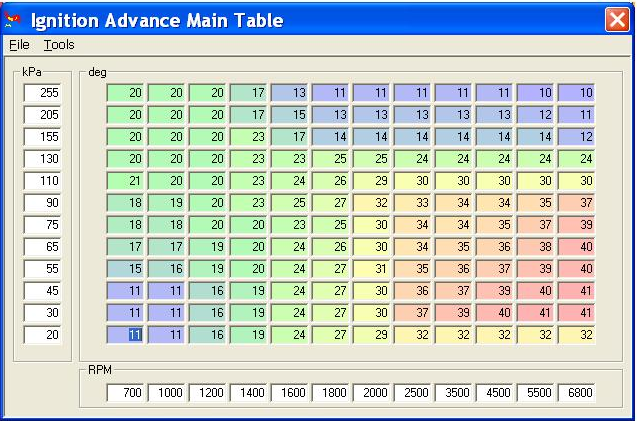
I still don't know the cause of the failure or even how old the headgasket was, nor the condition of it when I got the engine. For all I know it had already had partial failure when I got it...
I have a sneaking suspicion it could have been related to the noise in my wiring harness. So I got my hands on a good used harness and have it mostly installed. I will be trying to start the car without the accessories like my vTPS hooked up to hopefully get the car to start and see if I still have signal noise. If I still have issues, I will methodically eliminate the possible causes of the noise one by one as the car idles.
As it sits right now:
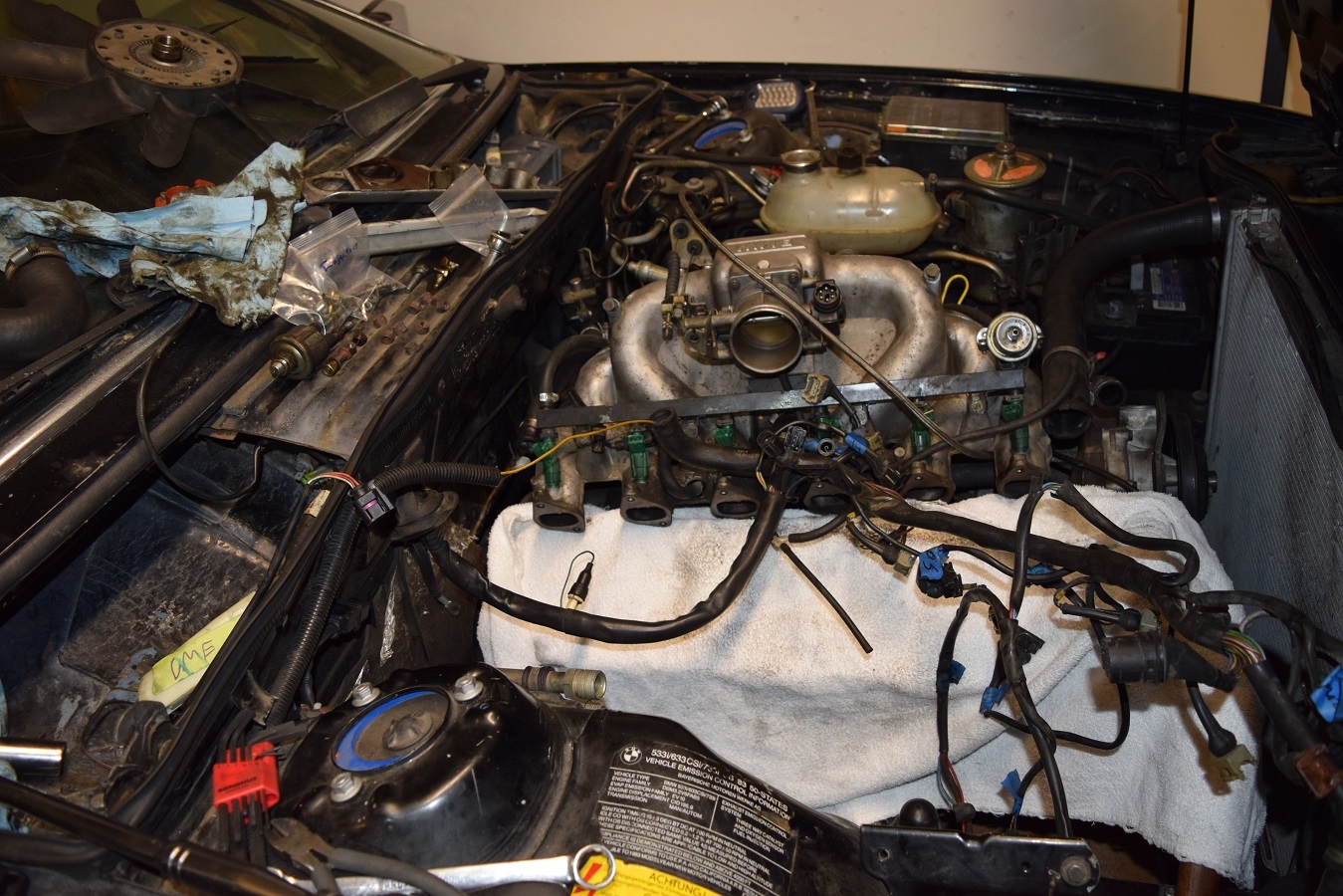
The head is still out being disassembled and then milled. Apparently it is only .003" away from being flat but had some leakage through the valves. The cam also had some wear so I am hoping I can use my spare (from the head that has the corrosion in the cooling passage near cyl #6.
With that in mind I decided to compare a TCD turbo manifold I picked up earlier this year to my Callaway manifold:
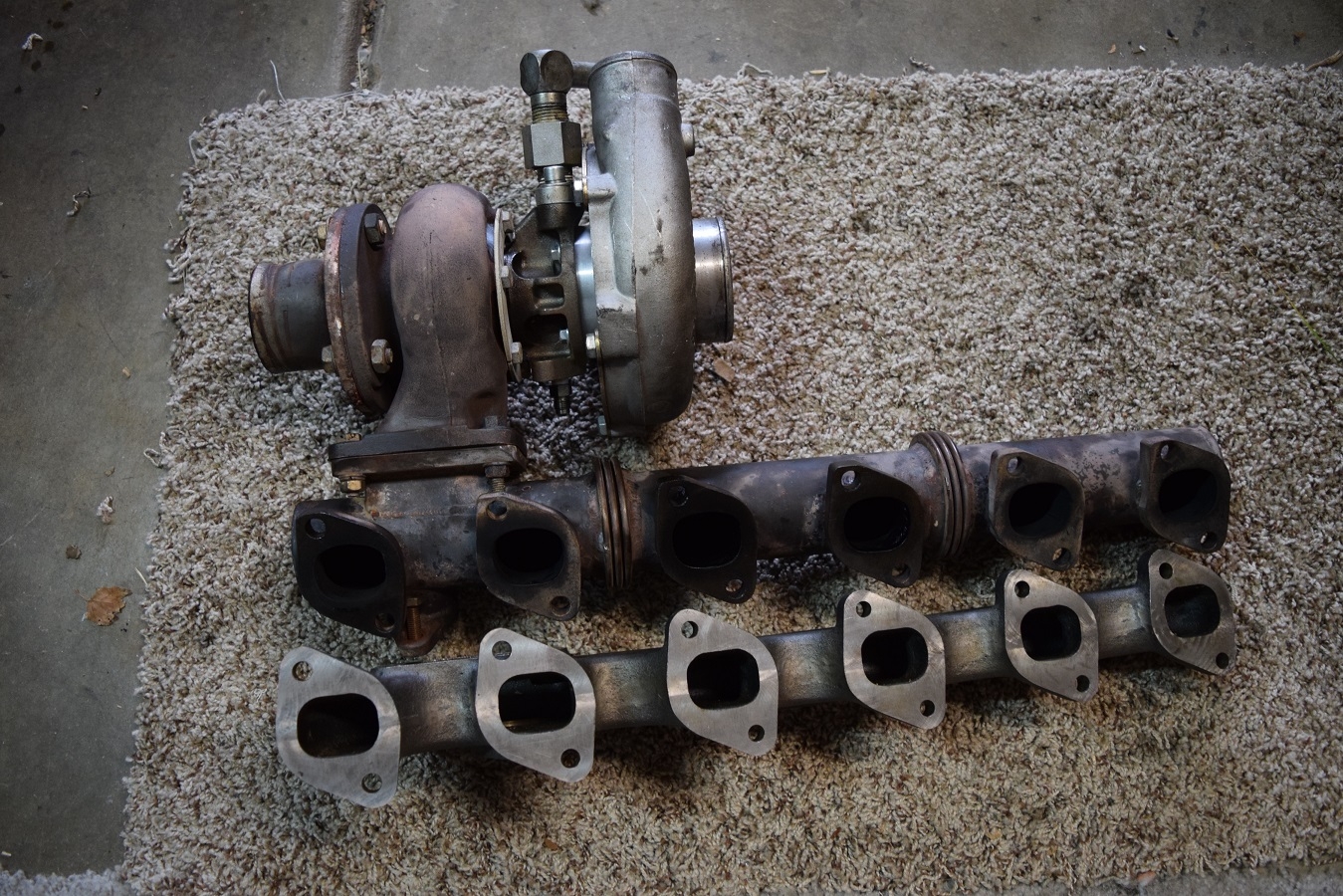
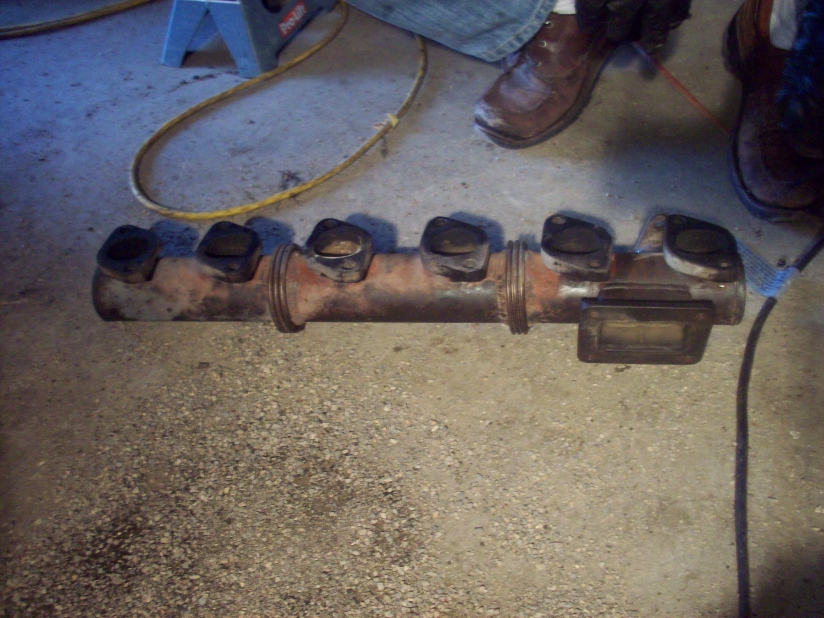
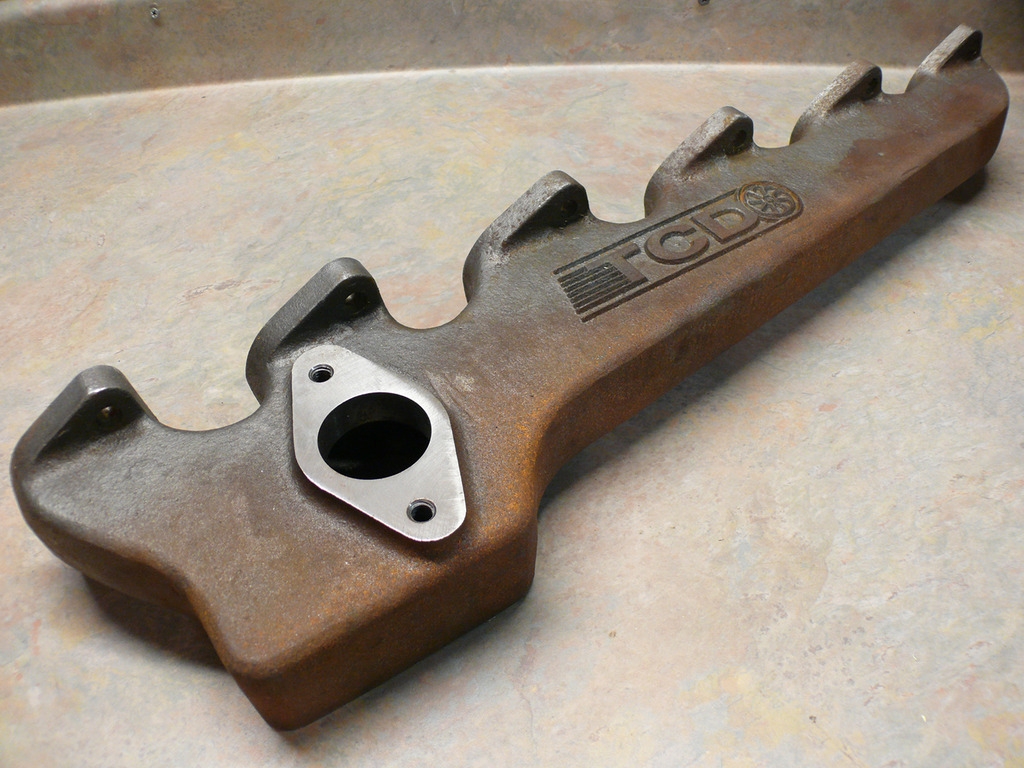
Upon initial inspection, you can see the callaway manifold is really just a few of cylinders welded together and then connected to some openings that are connected to the mounting flanges. I noticed right away that the TCD manifold has smooth features and appears to be easier to mount due to the shape of the flow path.
So reading on turbo exhaust design via Maximum Boost and noted the following:
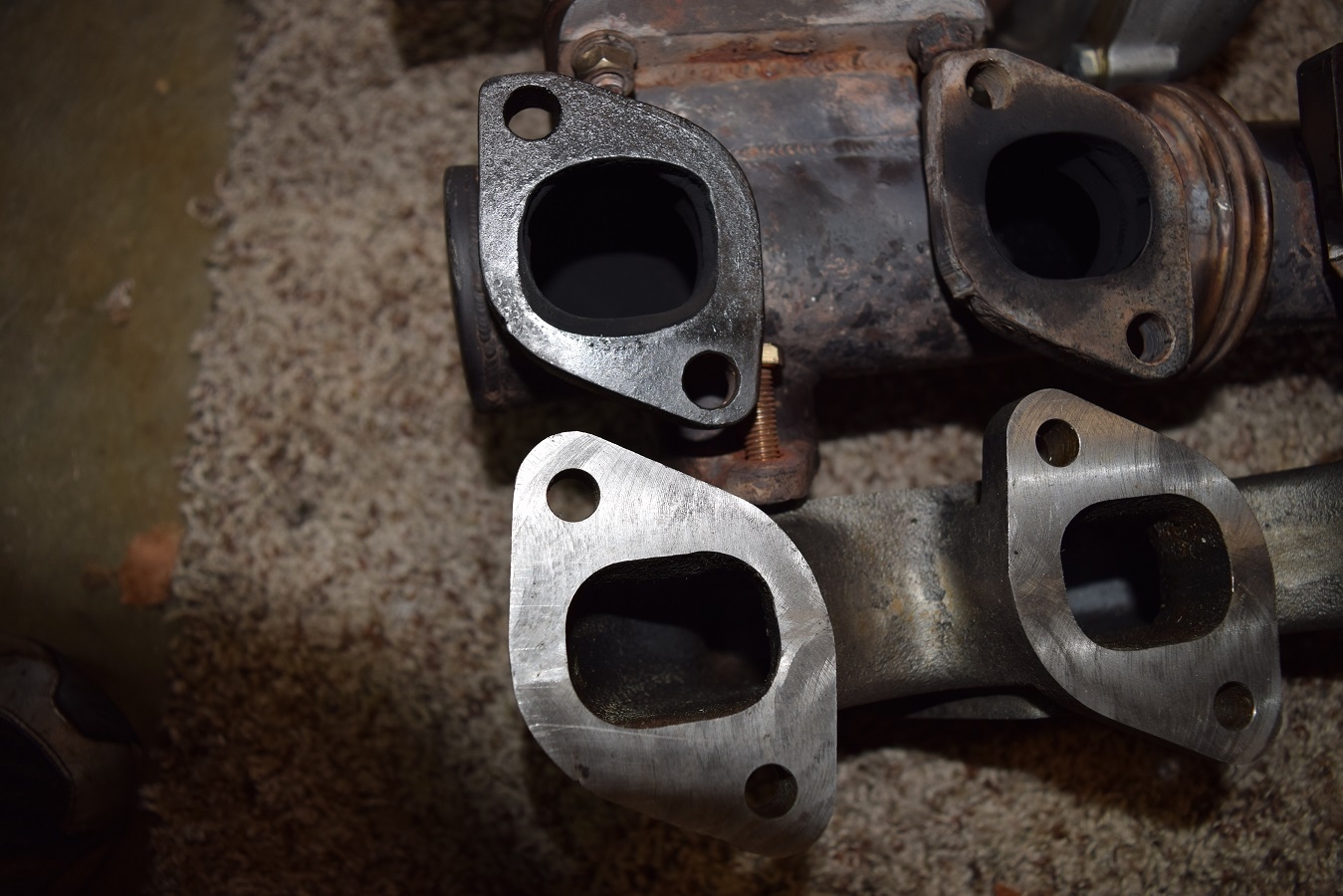
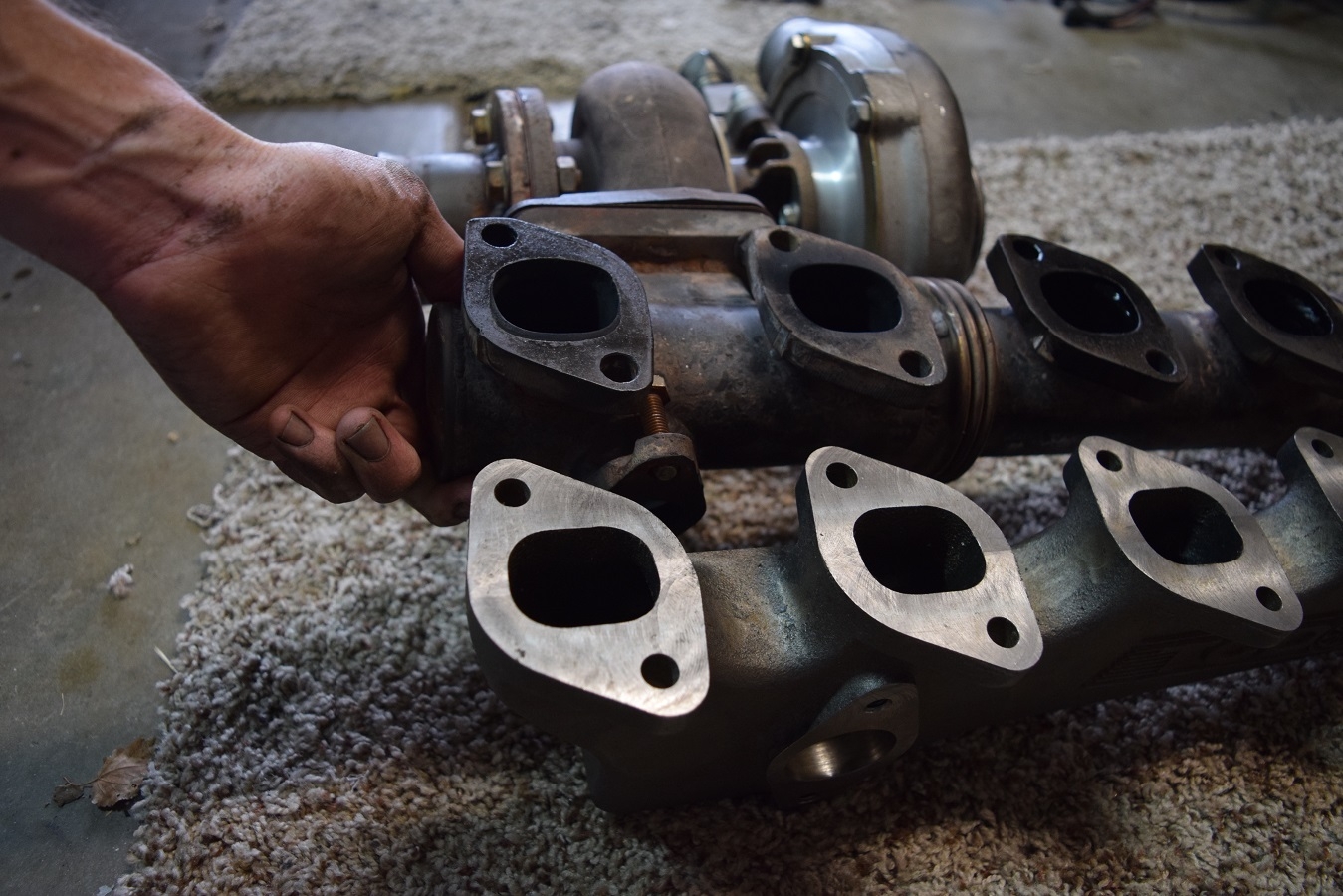
In my measurements, the turbo will sit slightly closer to the block, but it will also move the turbo forward. It will move the turbo up slightly as well.
I think this means more clearance for the compressor outlet/intercooler pipe and both the motor mount and front subframe, a little extra height for the oil drain tube, and more clearance for compressor inlet tube.
I'm going to try to install it on the car when I reassemble. The smooth flow path, better clearance and better access to mounting studs all makes me think want to do this from the fitment perspective. From the design perspective it appears obvious that the smooth flow path should improve performance as well. The lack of sharp edges should minimize heat loss and the pulses should actually be directed towards the turbine rather than arbitrarily into the wall of a pipe. Lastly, the wastegate and turbine are also closer to the flow path and have less of a turn to make.
From my research, nothing here looks out of place except I may have the AFR targets slightly lean in the cruise range.
the 24* timing in the lower rpm's is also concerning, so I will be adjusting that down. Seems like a typo or something may have caused this. From my research, here is M Holtmeir's map from 2008 running 91 octane and a US B34 turbo...
I still don't know the cause of the failure or even how old the headgasket was, nor the condition of it when I got the engine. For all I know it had already had partial failure when I got it...
I have a sneaking suspicion it could have been related to the noise in my wiring harness. So I got my hands on a good used harness and have it mostly installed. I will be trying to start the car without the accessories like my vTPS hooked up to hopefully get the car to start and see if I still have signal noise. If I still have issues, I will methodically eliminate the possible causes of the noise one by one as the car idles.
As it sits right now:
The head is still out being disassembled and then milled. Apparently it is only .003" away from being flat but had some leakage through the valves. The cam also had some wear so I am hoping I can use my spare (from the head that has the corrosion in the cooling passage near cyl #6.
With that in mind I decided to compare a TCD turbo manifold I picked up earlier this year to my Callaway manifold:


Upon initial inspection, you can see the callaway manifold is really just a few of cylinders welded together and then connected to some openings that are connected to the mounting flanges. I noticed right away that the TCD manifold has smooth features and appears to be easier to mount due to the shape of the flow path.
So reading on turbo exhaust design via Maximum Boost and noted the following:
And from some other research:-heat retention and exhaust temperatures are key to the velocity of exhaust gases
-Thicker exhaust manifolds will lose heat faster than thin
-Manifolds with more surface area will conduct/lose more heat
-Reducing ambient airflow around the manifold will minimize heat loss
-Manifold heat wrap will retain too much heat and likely cause structural damage
-Heat distribution inside the manifold is important
-Sharp corners will cause localized hot spots and cause additional heat loss
-Reversion of cylinder events can cause back pressure and reduce performance
-Tube size is important. Always select the smaller diameter to increase exhaust velocity
-Streamlining flow in the manifold is important
-design passages to maintain constant velocity is beneficial
So upon further inspection it appears the TCD turbo manifold is designed better than my callaway unit. Some more photos for comparison:-Manifolds with long runners have been found to produce more power but less torque than manifolds with short runners
-Manifolds with short runners radiate less heat as they have less surface area so engine bay cooling is less of an issue and as less heat energy is lost more is available to drive the turbine - efficiency
-Manifolds with short runners give faster turbo spooling or pickup time than manifolds with long runners.
-Manifolds with equal length runners space the individual pulses of energy from exhaust ports evenly in time - this minimizes the possibility of reversion
-Runners on turbo manifolds should be of smaller diameter than normally aspirated manifolds, ideally the same size as exhaust ports so that exhaust gas pulse speed from the port is maintained, a larger diameter runner will slow down exhaust gasses by allowing them to expand and slow down before reaching the turbine
-Runners of unequal length cause turbulence as it takes finite time for an exhaust gas pulse to pass down the runner.
-There should be no steps in the flow of gasses through the manifold at any point, all joins should be matched and smoothed to minimise turbulence and eliminate hot spots.
In my measurements, the turbo will sit slightly closer to the block, but it will also move the turbo forward. It will move the turbo up slightly as well.
I think this means more clearance for the compressor outlet/intercooler pipe and both the motor mount and front subframe, a little extra height for the oil drain tube, and more clearance for compressor inlet tube.
I'm going to try to install it on the car when I reassemble. The smooth flow path, better clearance and better access to mounting studs all makes me think want to do this from the fitment perspective. From the design perspective it appears obvious that the smooth flow path should improve performance as well. The lack of sharp edges should minimize heat loss and the pulses should actually be directed towards the turbine rather than arbitrarily into the wall of a pipe. Lastly, the wastegate and turbine are also closer to the flow path and have less of a turn to make.
Last edited by tschultz on Nov 27, 2017 11:26 AM, edited 1 time in total.
Re: 633CSi Turbo - 11/24/2017 - Not Really Callaway Anymore
If you’re having issues with the harness, they should appear in your data logs by the way of dropping out...unlesss power to the ECU is being interupted. I switched to the m50 tps earlier this year after the response time became super laggy.
I would highly recommend having whatever manifold you use ceramic coated. It’s an easy way to reduce underhood temps. After some frustration last year, I came up with a method to first install the TCD manifold on the motor and then the turbo. Much easier to tighten the lower manifold nuts this way. Let me know if you need any tips/tricks.
I would highly recommend having whatever manifold you use ceramic coated. It’s an easy way to reduce underhood temps. After some frustration last year, I came up with a method to first install the TCD manifold on the motor and then the turbo. Much easier to tighten the lower manifold nuts this way. Let me know if you need any tips/tricks.
-
Nebraska_e28
- Beamter

- Posts: 9071
- Joined: Apr 13, 2006 11:18 PM
- Location: Council Bluffs, IA
- Contact:
Re: 633CSi Turbo - 11/24/2017 - Not Really Callaway Anymore
I'd run the TCD over Callaway any day for better efficiency and less backpressure at higher boost levels. On the other hand, if keeping with the original Callaway theme that's another thing. Of course safe boost would be your best friend. Comments from an novice.
Re: 633CSi Turbo - 11/24/2017 - Not Really Callaway Anymore
but is that factually correct though?Nebraska_e28 wrote:I'd run the TCD over Callaway any day for better efficiency and less backpressure at higher boost levels.
Re: 633CSi Turbo - 11/24/2017 - Not Really Callaway Anymore
I never put both manifolds on a flow bench but common sense probably prevales.Shadow wrote:but is that factually correct though?Nebraska_e28 wrote:I'd run the TCD over Callaway any day for better efficiency and less backpressure at higher boost levels.
Re: 633CSi Turbo - 11/24/2017 - Not Really Callaway Anymore
Since the last post was so many words, I tried to get a bunch of photos for this update:
With the head out to be reworked, I spent some time cleaning up the block. For some reason, there was a lot of build up on the deck, but going slowly I used a razor blade to get it all smooth to the touch.
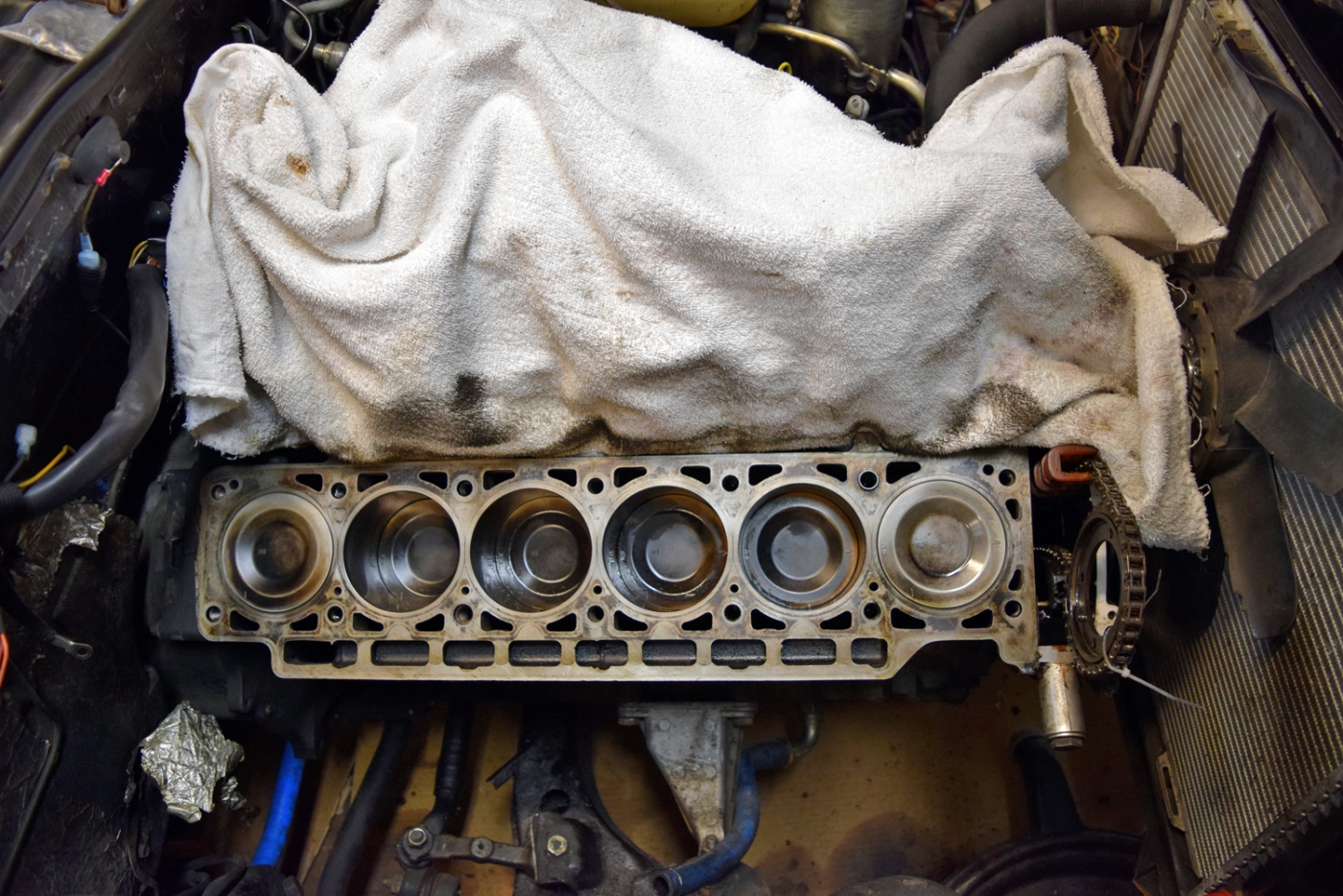
Considering the suggestions for these on this board and a few other individuals, I decided to send the manifold off to be ceramic coated by a shop here in Denver since I was waiting on the head anyway. Once I got it back, I felt silly because I realized I should have also done the turbine housing.
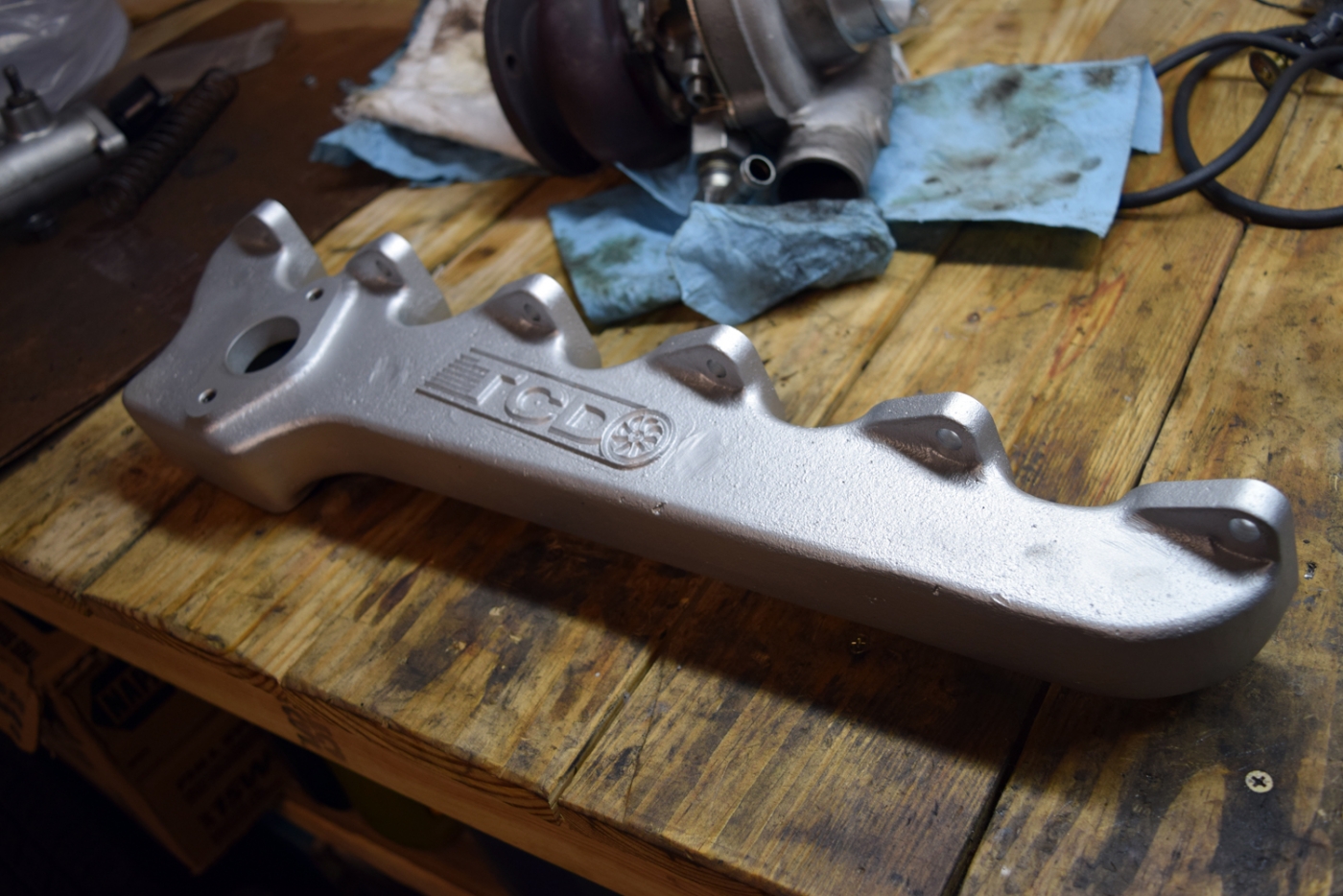
Here is the TCD manifold with gaskets-- to show what I was writing about earlier.
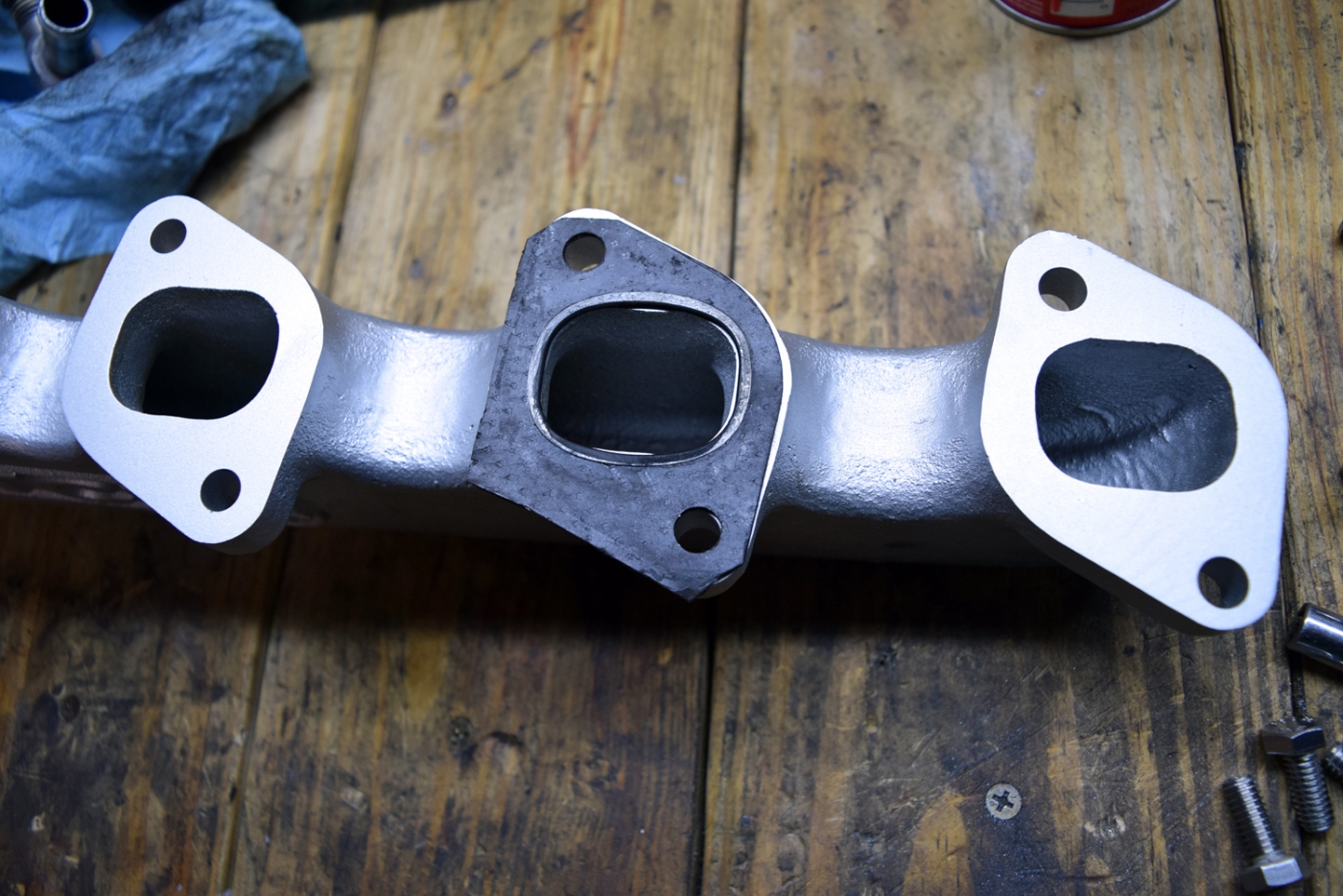
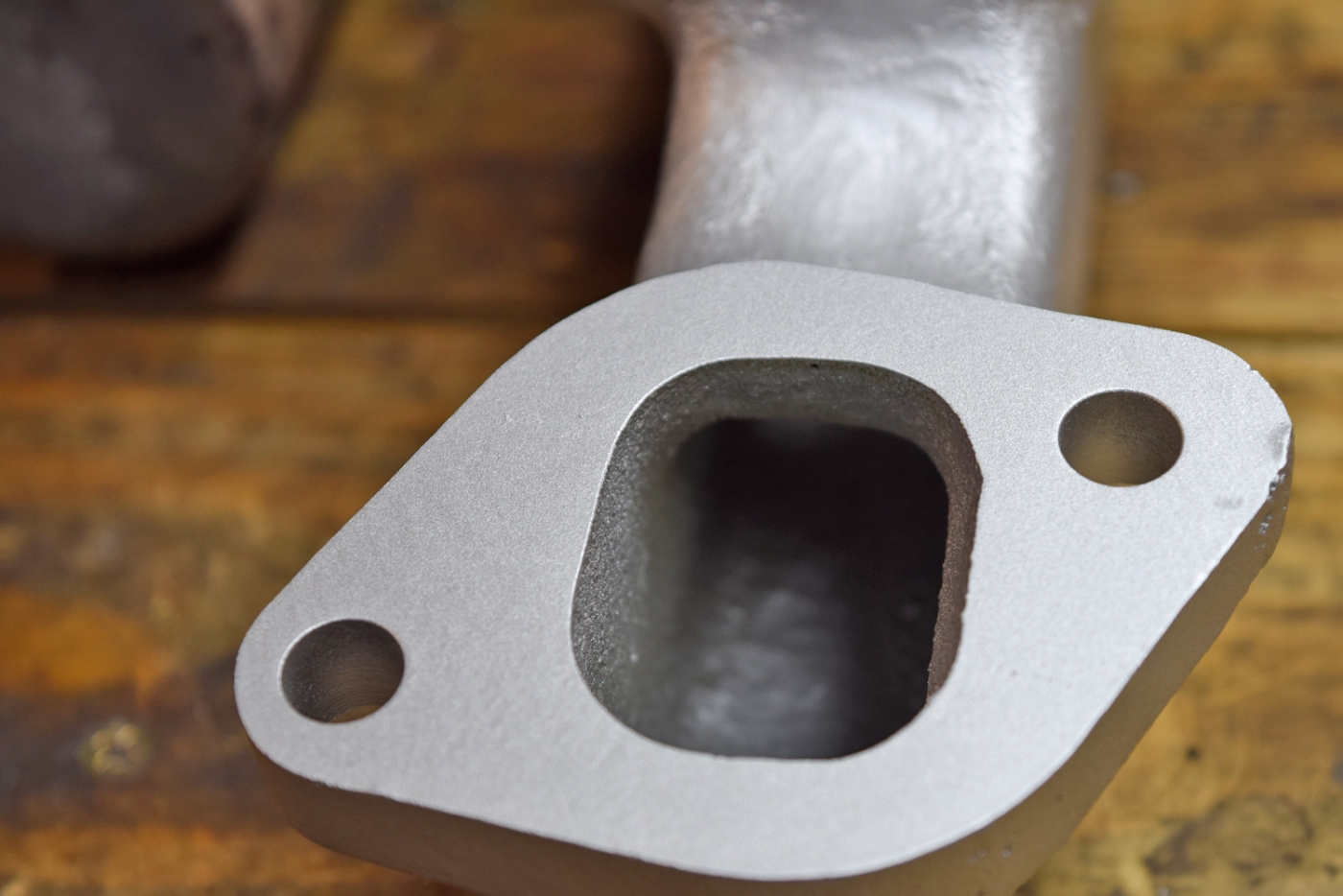
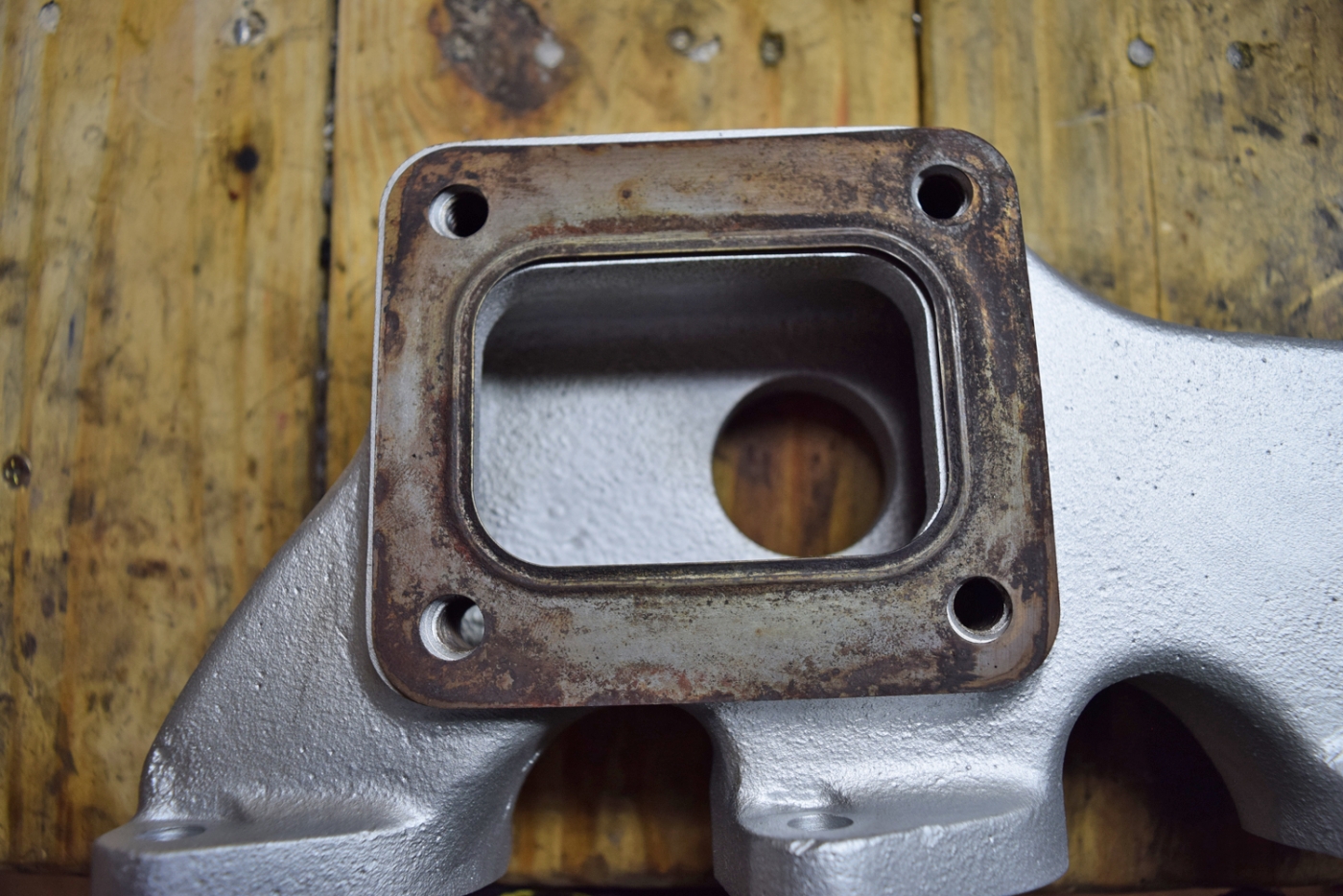
And the Callaway manifold for comparison. It is slightly lighter than the TCD, but overall seems like poor flow path design.
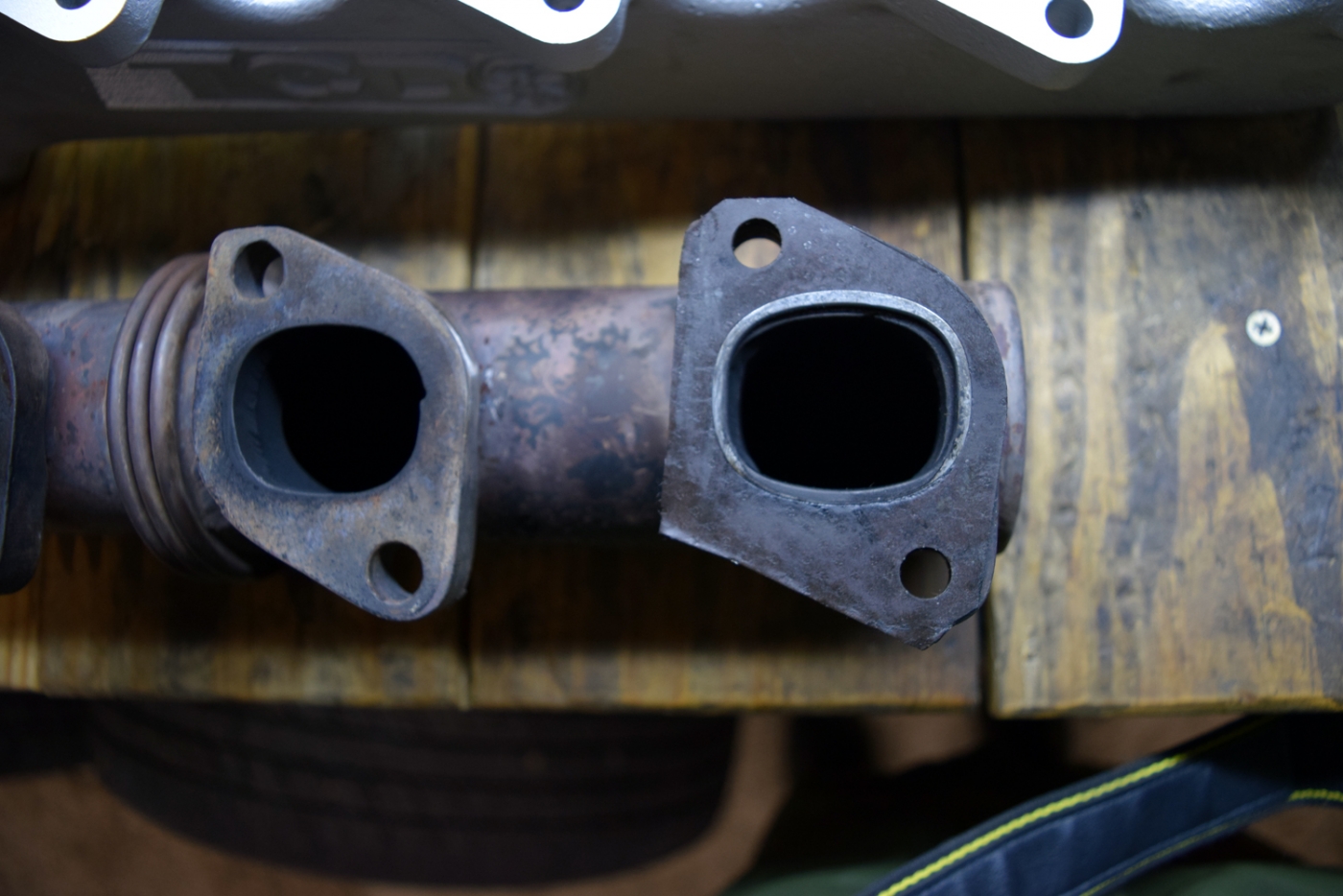
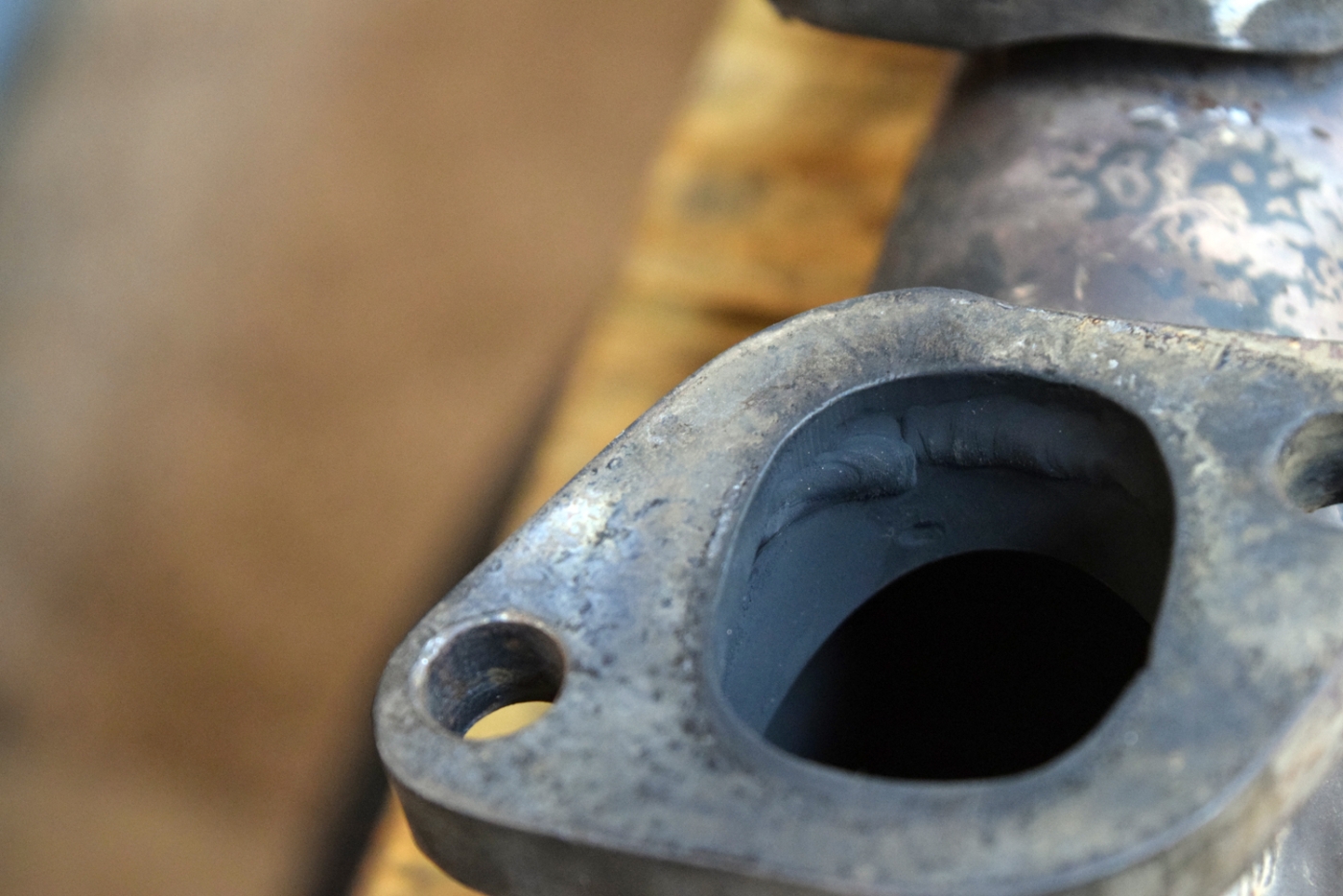
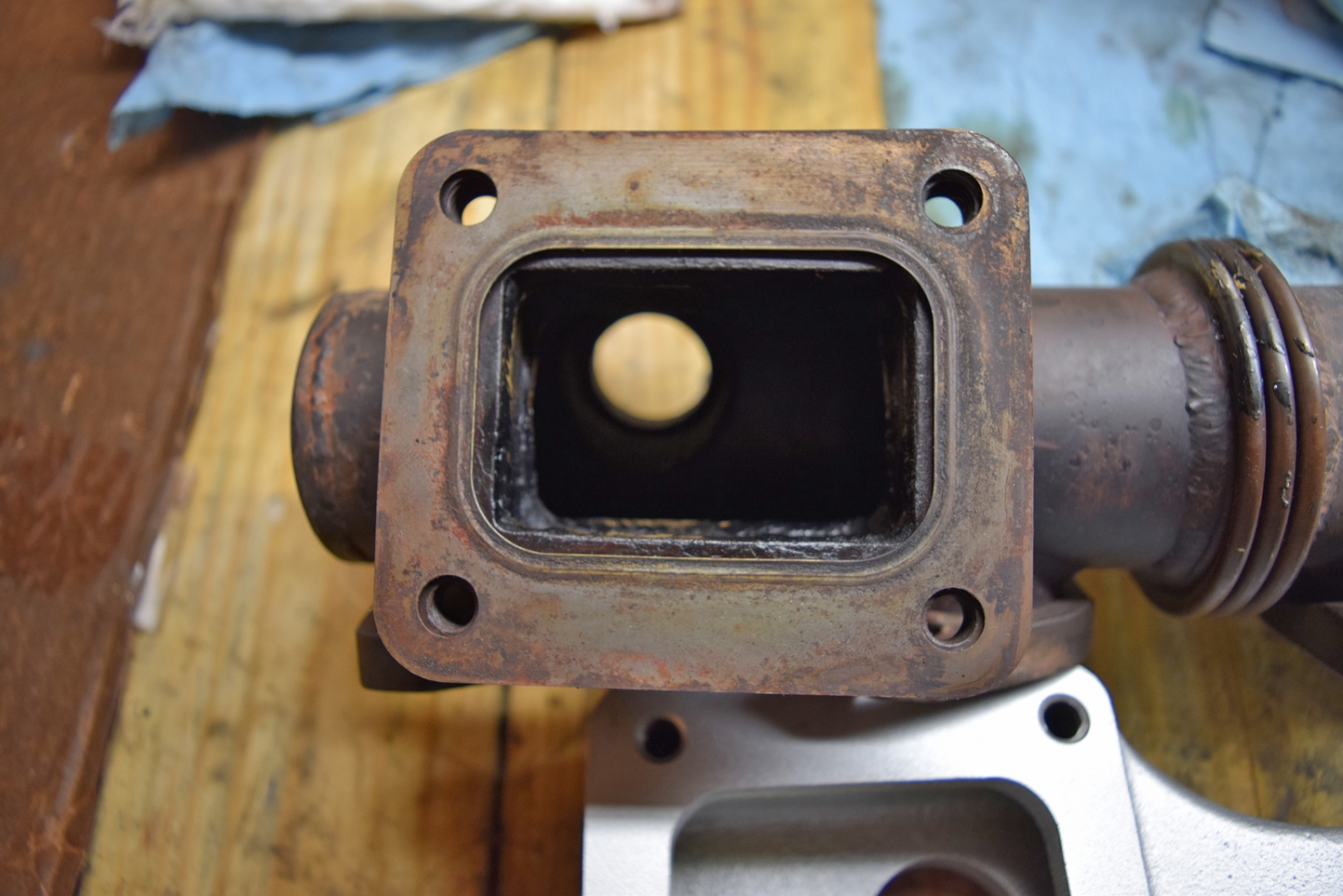
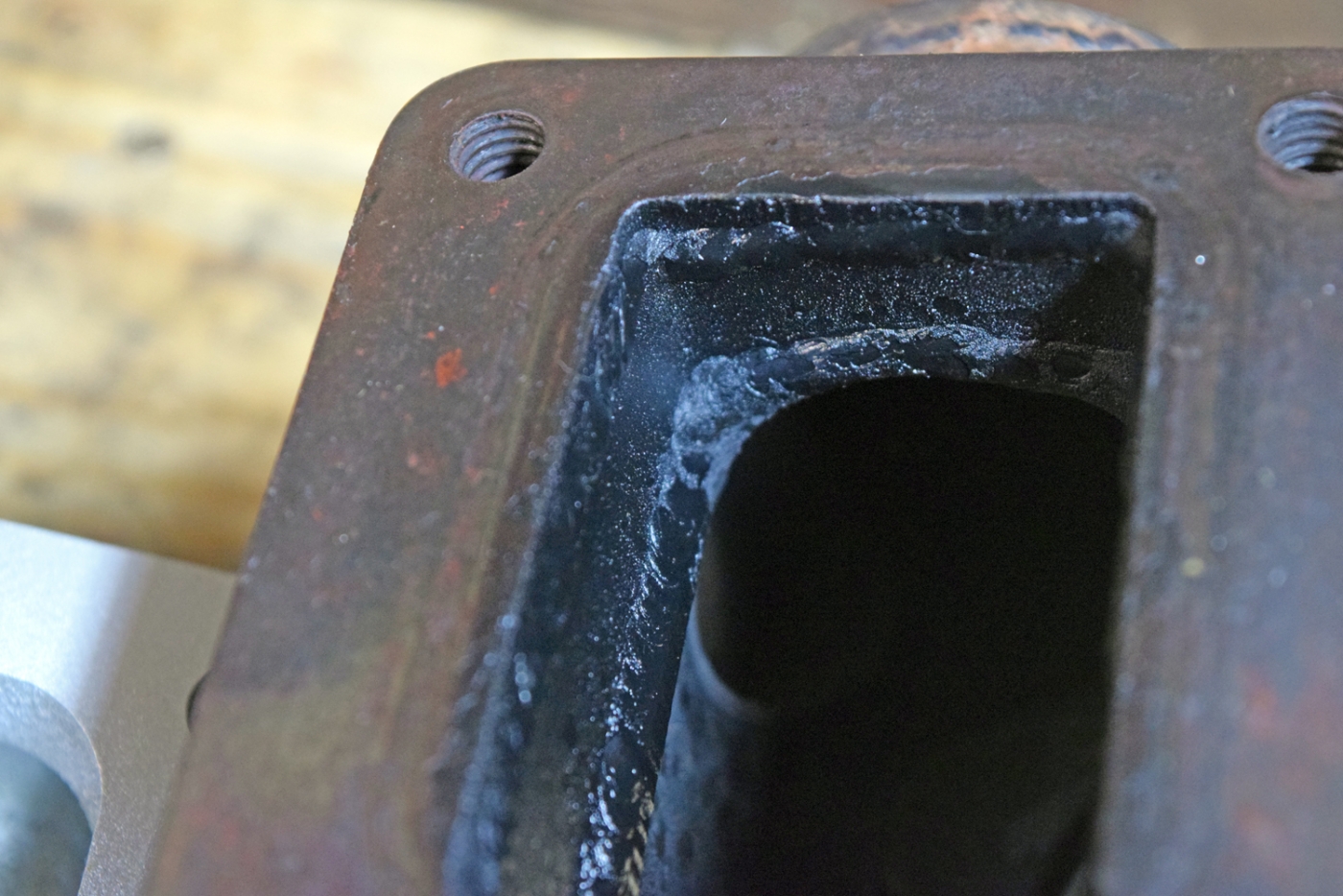
My spare head that I thought had a good cam ended up being scored due to somebody who tightened down the banjo bolts and didn't replace the crush washers. The rebuilder didn't want to reuse it.
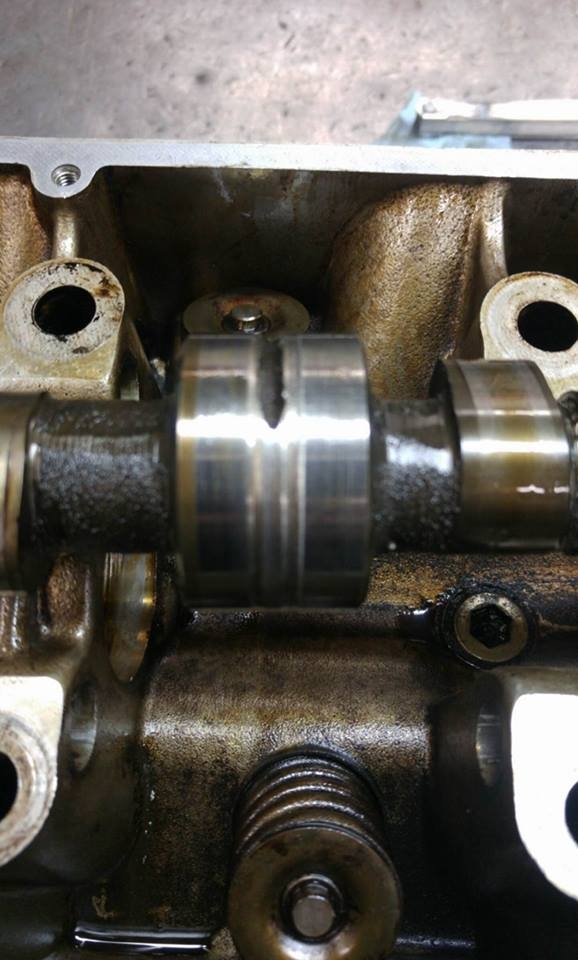
So I did some research on cams. Below is a great comparison via Devinder. The cam profile detail isn't easy to find:
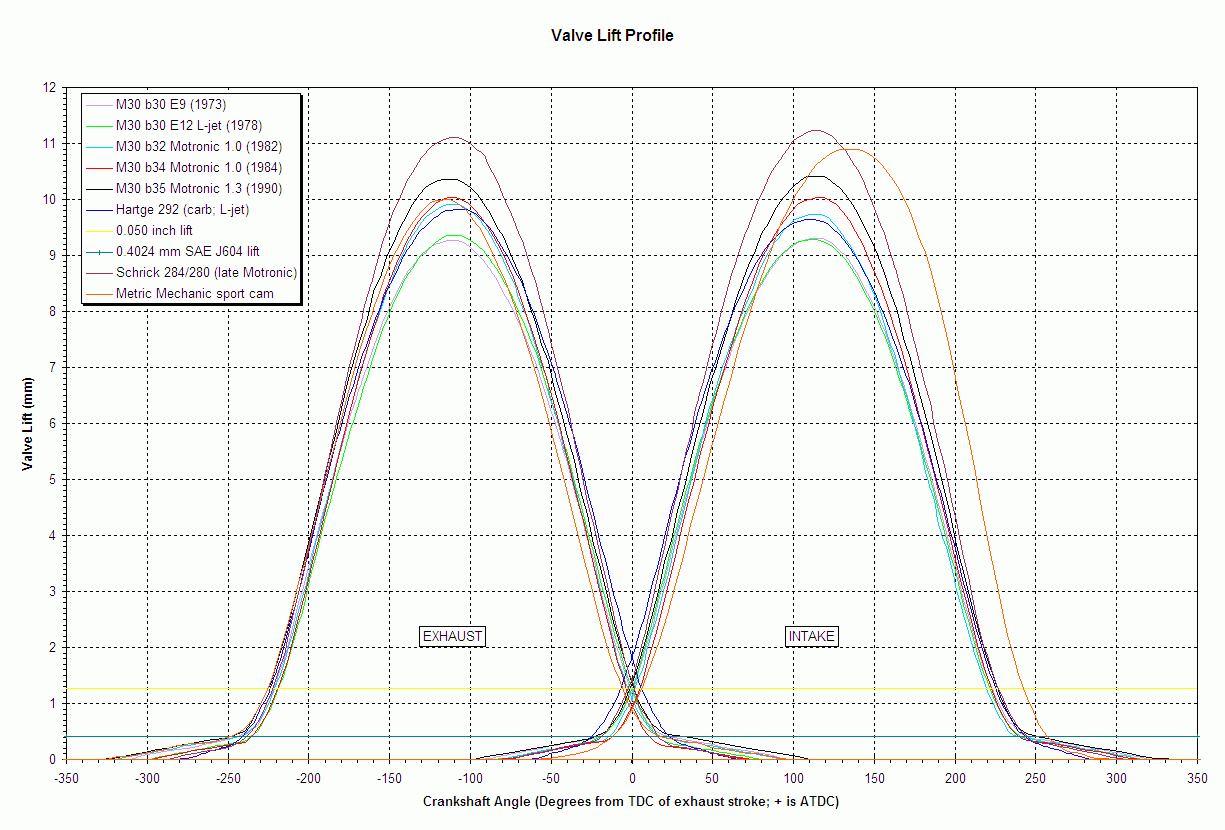
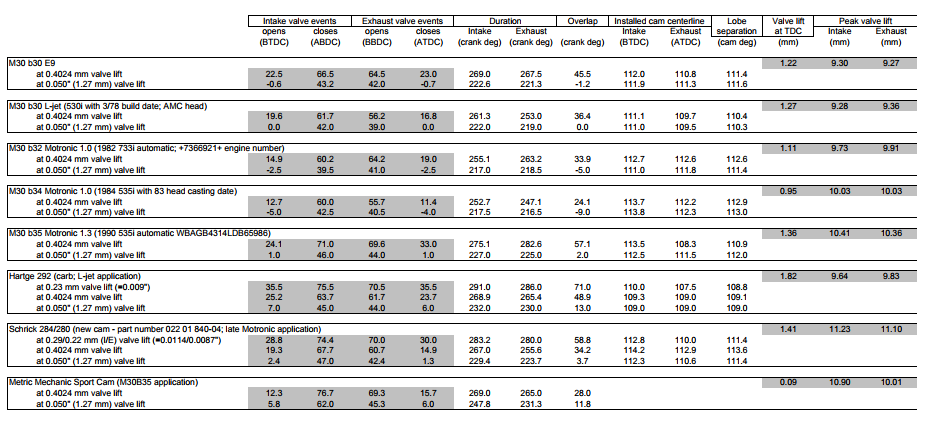
The B35 cam was the best choice for bang for the buck for a replacement. It should change the power profile of the engine from more torque than hp to about even. This cam has the higher lift which should also allow the turbo to get more air through the engine. I wanted to get larger valves but the machinist didn't feel comfortable doing it. From my research it should shift power up about 400rpm in the curve and the additional flow should net some percentage of power also. I'll do a comparison to my VirtualDyno plots a couple pages back.
The head back from the shop:
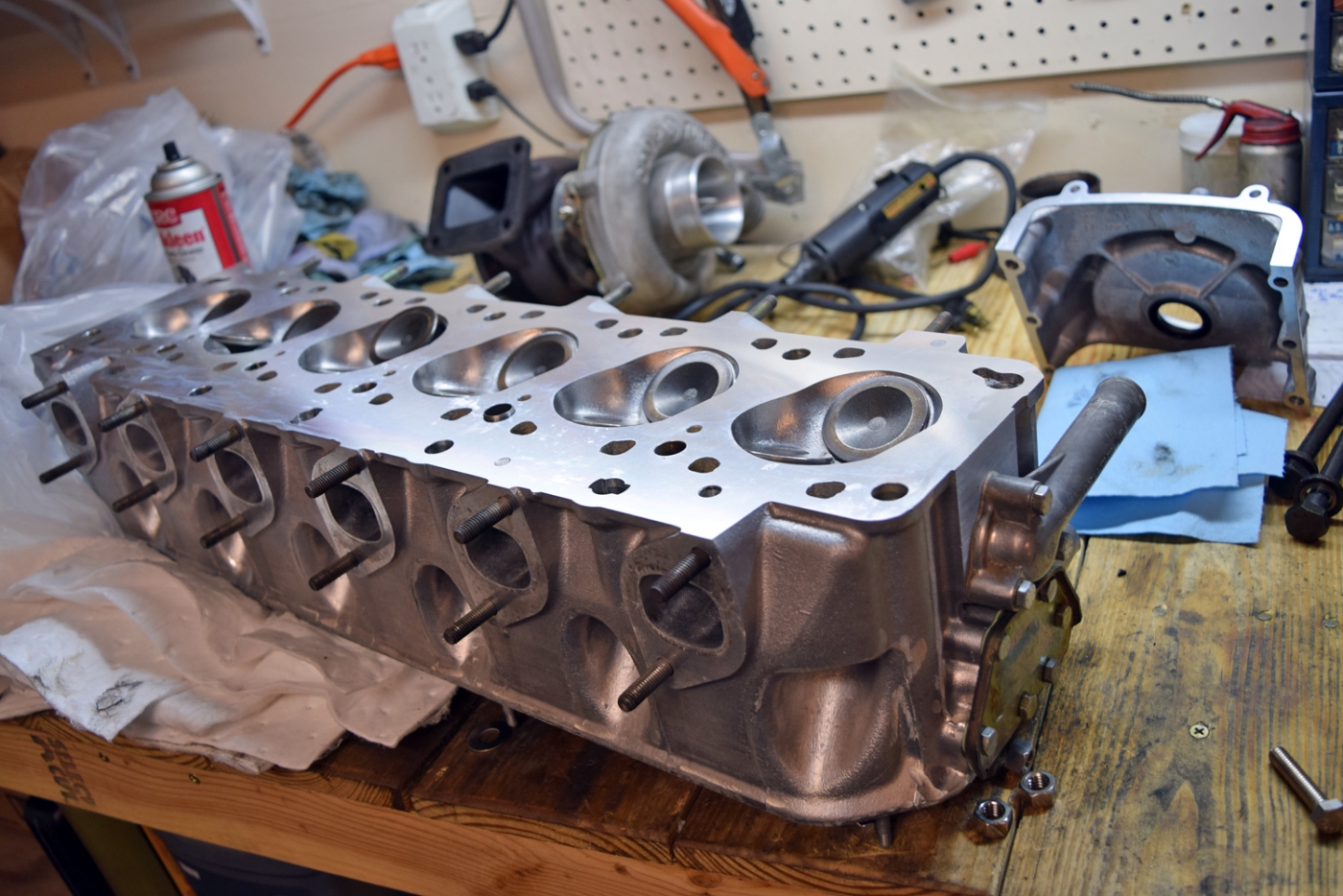
3 Angle Valve grind on all 12 valves (~10% flow increase). I don't think he could do a back cut but that would have been awesome if he did:
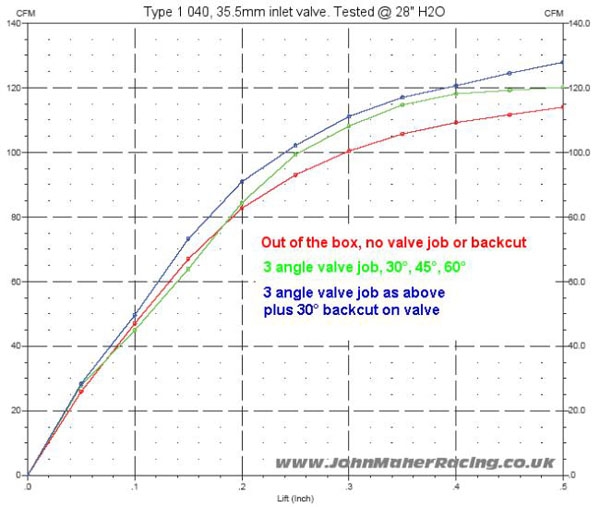
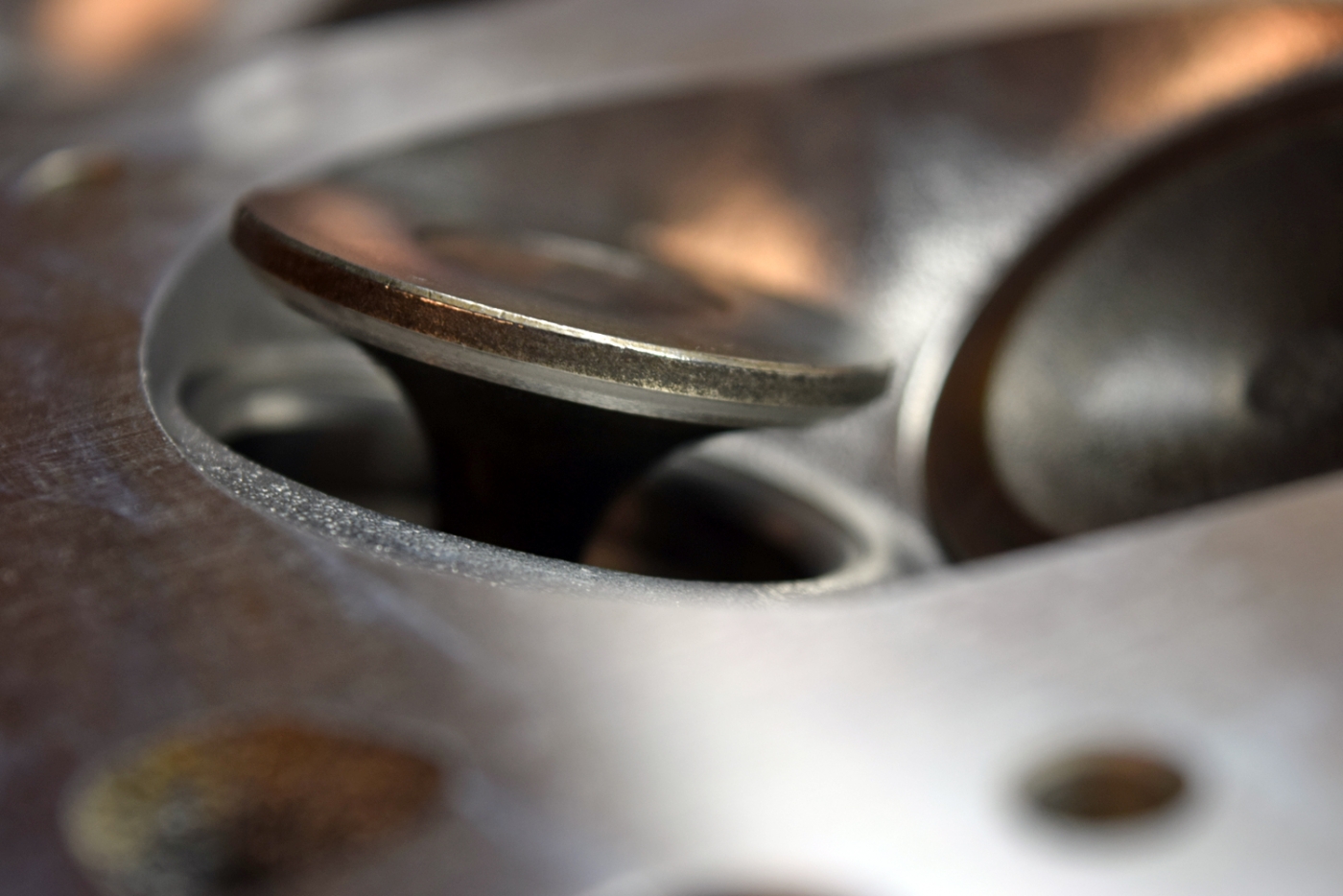
I also went with ARP head studs as an upgrade, but elected for stock Elring gasket. So far I torqued in 3 stages to 80 ft-lbs, but wasn't sure about going to 90. The lubricating grease seems to be some useful stuff. It took me a while to apply it to washers, bolt threads and nuts as instructed.
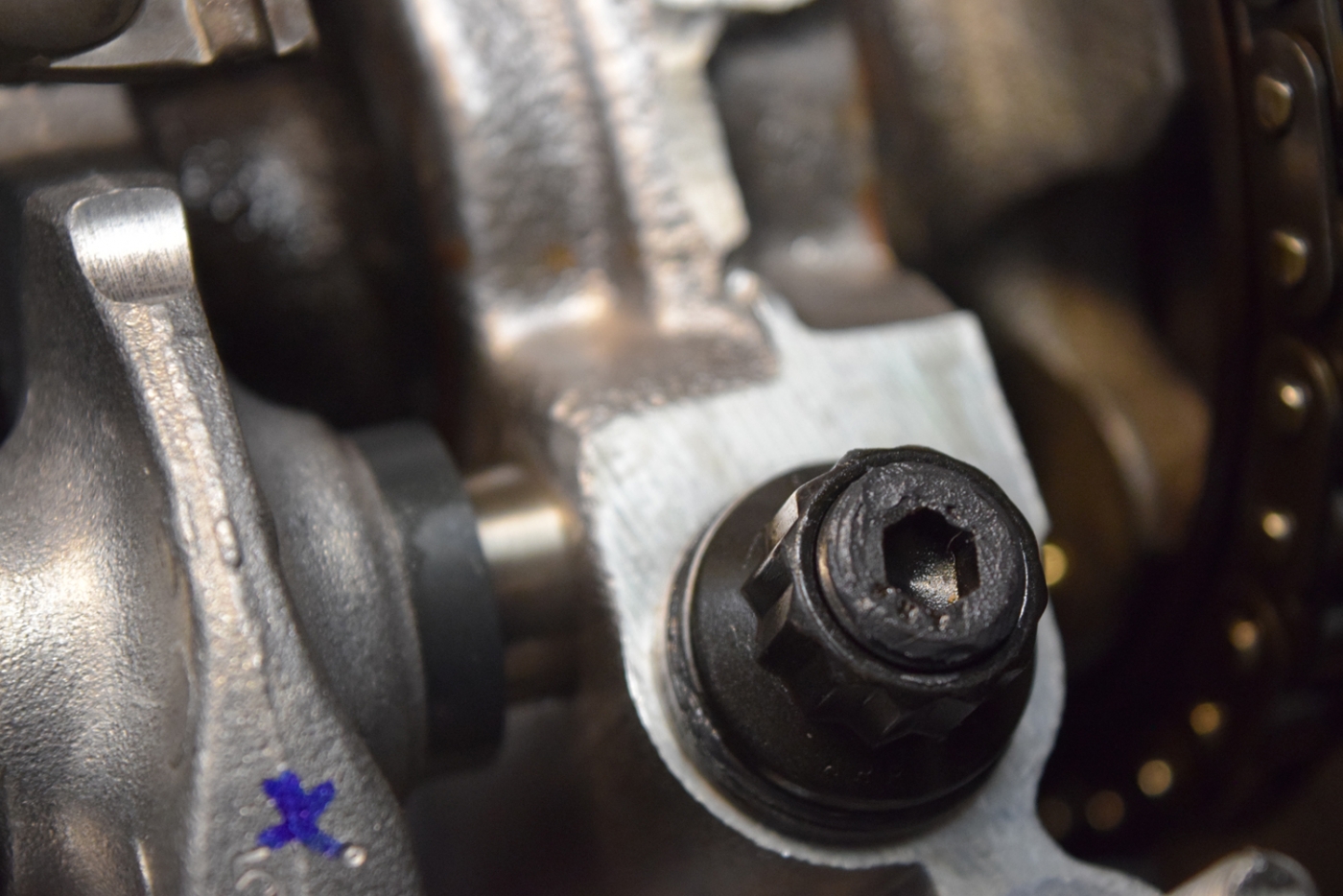
I also adjusted the valves. .010 on intake and .012 exhaust on the valve side per Mark Hutto
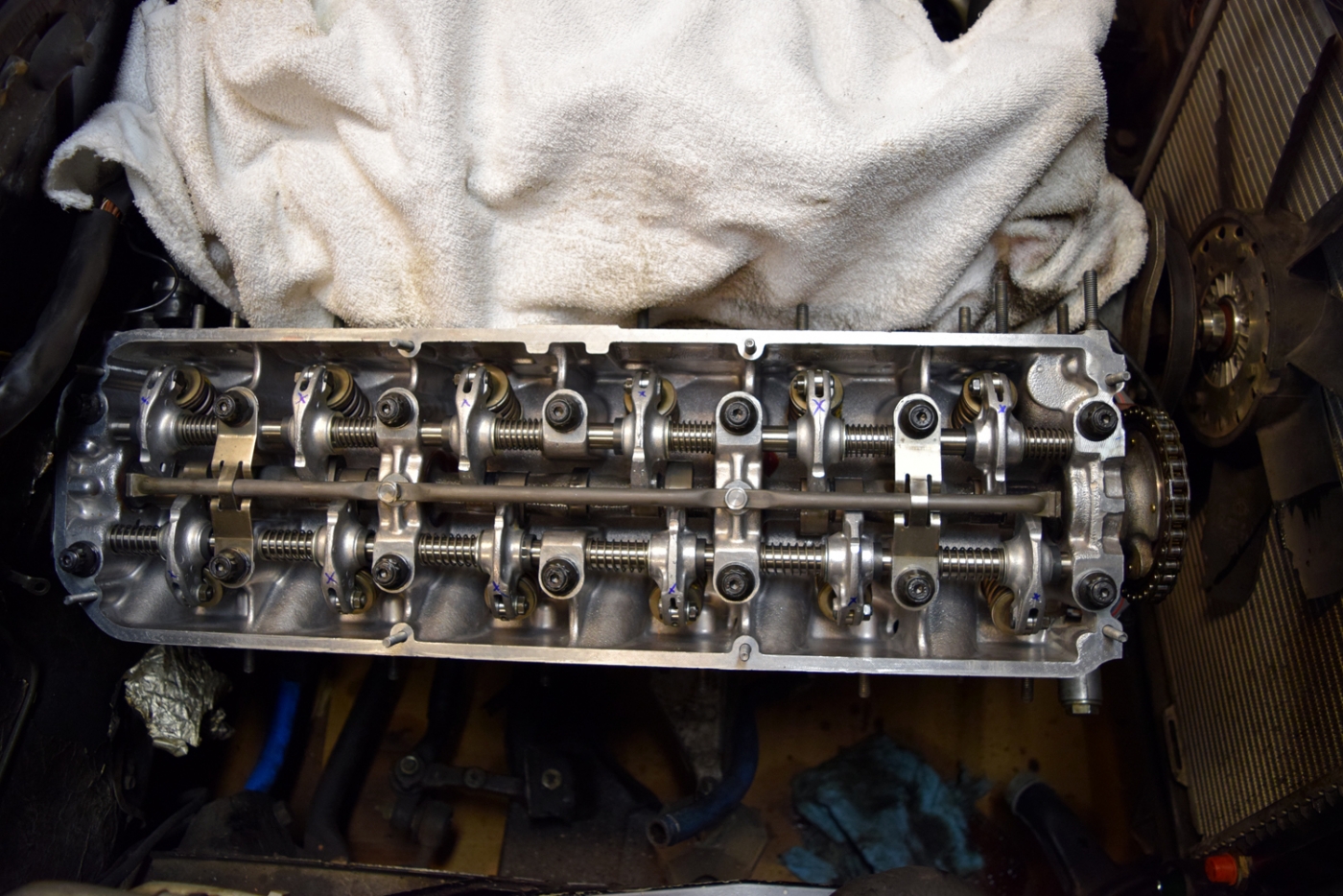
I tried to mount the turbo in the same orientation as with the Callaway manifold, but hit an unexpected snag. I found that the compressor housing hits the block in the orientation as the Callaway turbo manifold. After wrestling with it for probably 45 minutes, I finally got it clocked to an orientation that would work, which is the orientation for TCD intercooler.
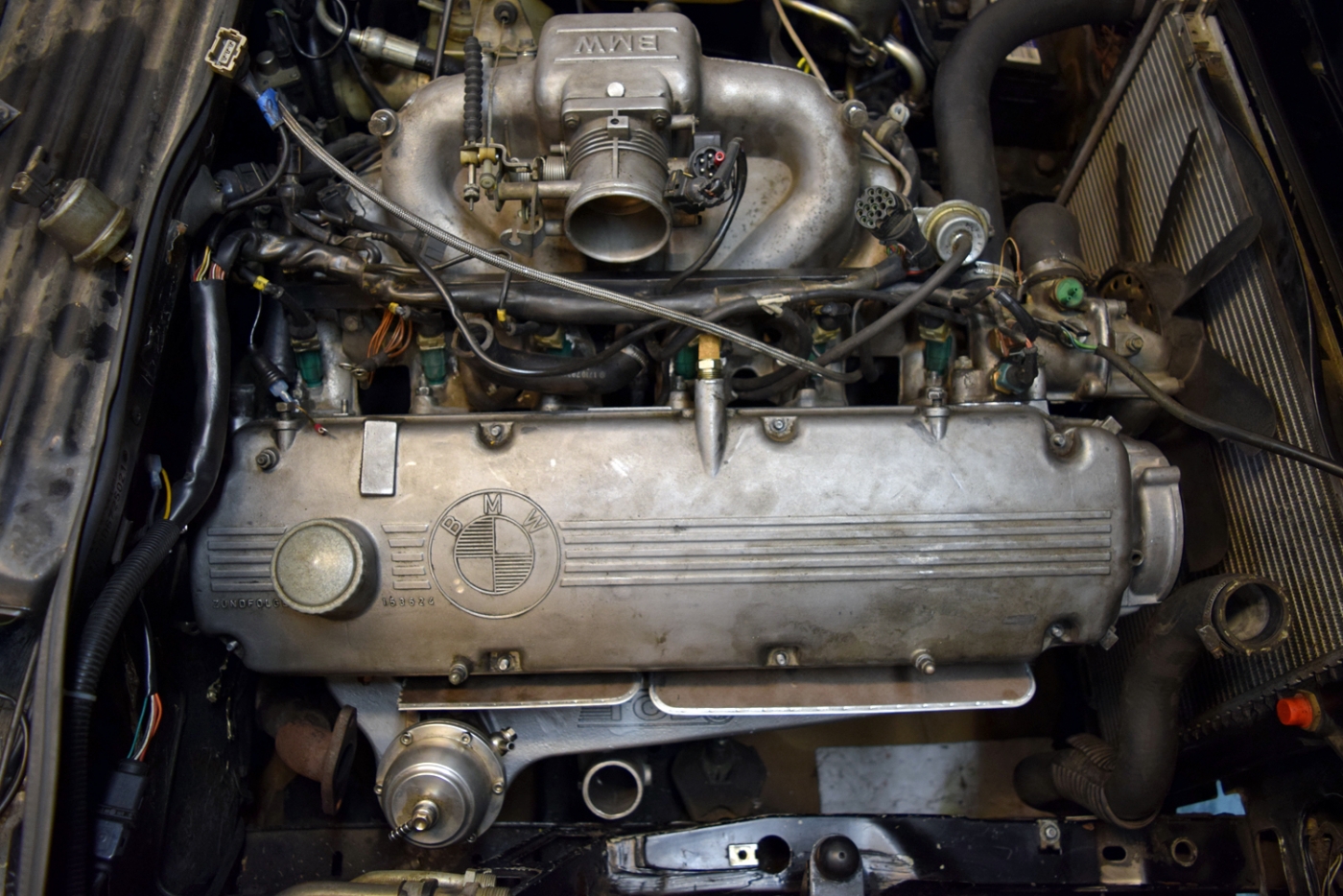
I'm going to have to look at it and route the piping differently to use my air to air. So here are the parts otherwise all mocked up.
I have to look at the wastegate dump and see about getting that pipe remade. I didn't fit the exhaust but that may have to be adjusted slightly also. Good news was everything else seemed to fit about the same (I expected that).
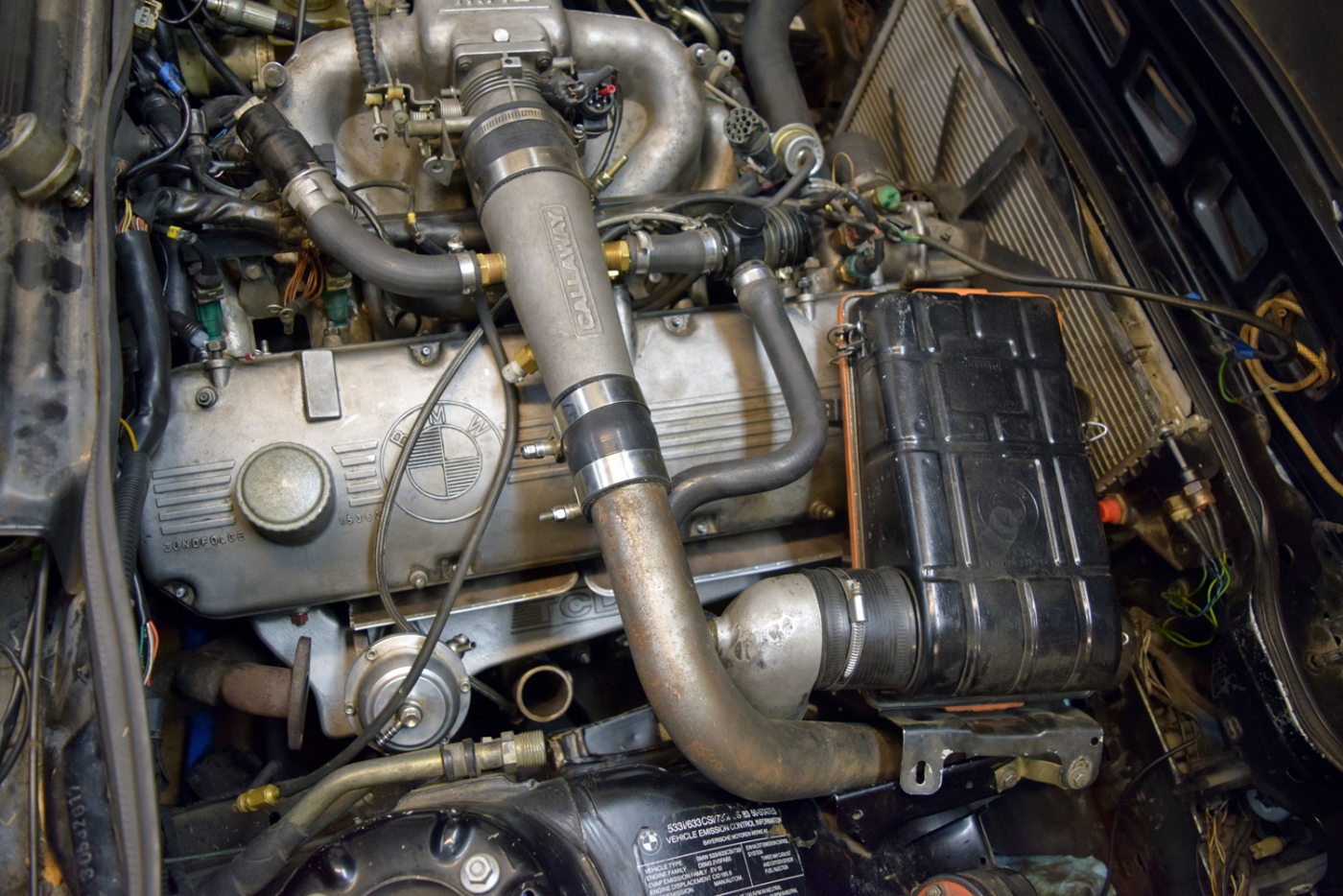
This is the space I am lookign to route the compressor outlet... maybe around the inlet pipe and down the frame rail to the intercooler piping. It's going to take a bit more time that I expected. It will also look homebrew silly, but I think that's pretty funny as long as it functions well.
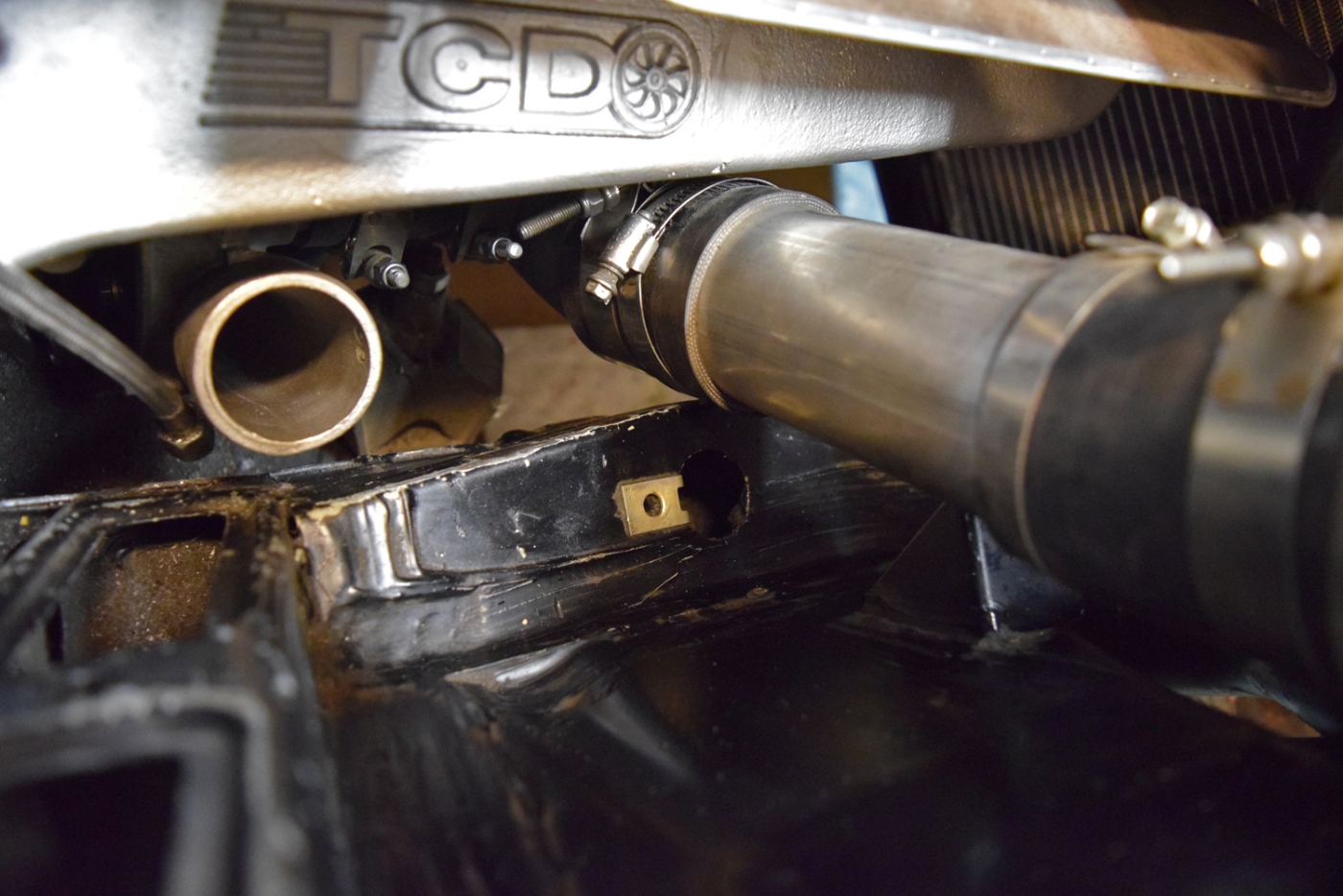
I also need to add fluids, reconnect cap/rotor/plugs/wires, and rewire a few items to work with MS2. Right now all but the TPS use harness adapters.
With the head out to be reworked, I spent some time cleaning up the block. For some reason, there was a lot of build up on the deck, but going slowly I used a razor blade to get it all smooth to the touch.

Considering the suggestions for these on this board and a few other individuals, I decided to send the manifold off to be ceramic coated by a shop here in Denver since I was waiting on the head anyway. Once I got it back, I felt silly because I realized I should have also done the turbine housing.

Here is the TCD manifold with gaskets-- to show what I was writing about earlier.



And the Callaway manifold for comparison. It is slightly lighter than the TCD, but overall seems like poor flow path design.




My spare head that I thought had a good cam ended up being scored due to somebody who tightened down the banjo bolts and didn't replace the crush washers. The rebuilder didn't want to reuse it.

So I did some research on cams. Below is a great comparison via Devinder. The cam profile detail isn't easy to find:

The B35 cam was the best choice for bang for the buck for a replacement. It should change the power profile of the engine from more torque than hp to about even. This cam has the higher lift which should also allow the turbo to get more air through the engine. I wanted to get larger valves but the machinist didn't feel comfortable doing it. From my research it should shift power up about 400rpm in the curve and the additional flow should net some percentage of power also. I'll do a comparison to my VirtualDyno plots a couple pages back.
The head back from the shop:

3 Angle Valve grind on all 12 valves (~10% flow increase). I don't think he could do a back cut but that would have been awesome if he did:


I also went with ARP head studs as an upgrade, but elected for stock Elring gasket. So far I torqued in 3 stages to 80 ft-lbs, but wasn't sure about going to 90. The lubricating grease seems to be some useful stuff. It took me a while to apply it to washers, bolt threads and nuts as instructed.

I also adjusted the valves. .010 on intake and .012 exhaust on the valve side per Mark Hutto

I tried to mount the turbo in the same orientation as with the Callaway manifold, but hit an unexpected snag. I found that the compressor housing hits the block in the orientation as the Callaway turbo manifold. After wrestling with it for probably 45 minutes, I finally got it clocked to an orientation that would work, which is the orientation for TCD intercooler.

I'm going to have to look at it and route the piping differently to use my air to air. So here are the parts otherwise all mocked up.
I have to look at the wastegate dump and see about getting that pipe remade. I didn't fit the exhaust but that may have to be adjusted slightly also. Good news was everything else seemed to fit about the same (I expected that).

This is the space I am lookign to route the compressor outlet... maybe around the inlet pipe and down the frame rail to the intercooler piping. It's going to take a bit more time that I expected. It will also look homebrew silly, but I think that's pretty funny as long as it functions well.

I also need to add fluids, reconnect cap/rotor/plugs/wires, and rewire a few items to work with MS2. Right now all but the TPS use harness adapters.
Re: 633CSi Turbo - 12/22/2017 - Not Really Callaway Anymore
I'm really enjoying this thread. So much here I have no practical knowledge of, but intense curiosity for. Thanks for all the writeup and pics!
Re: 633CSi Turbo - 12/22/2017 - Not Really Callaway Anymore
Good to hear Charlie, thanks! Interesting to see this too because I admire the thoroughness (and cleanliness) of your builds alsocek wrote:I'm really enjoying this thread. So much here I have no practical knowledge of, but intense curiosity for. Thanks for all the writeup and pics!
Re: 633CSi Turbo - 12/22/2017 - Not Really Callaway Anymore
The manifold looks good with the ceramic coating. Nice work. The e24 chassis is pretty tight with the TCD m30 manifold. I ran into the same issu last winter when pulling my turbo. It's tight but it fits. What does the intercooler look like? The core suppurt hangs pretty low on these cars so you should be able to go low without it being the lowest problems.
Re: 633CSi Turbo - 12/22/2017 - Not Really Callaway Anymore
It was difficult to fit! I left the bolts loose to be able to clock it out of position before clocking it back once installed. This gave me the necessary clearance to the inner fender. I actually jacked up the engine partially for extra clearance and it was tighter than the Callaway orientation to fit the combo past the exhaust studs.
The #5 upper exhaust nut was difficult, but doable to tighten. Hopefully I don't have to remove this setup for quite a while!
Here's the intercooler and old piping. The bend on the right is different now and may change when I play with it in the next few days.
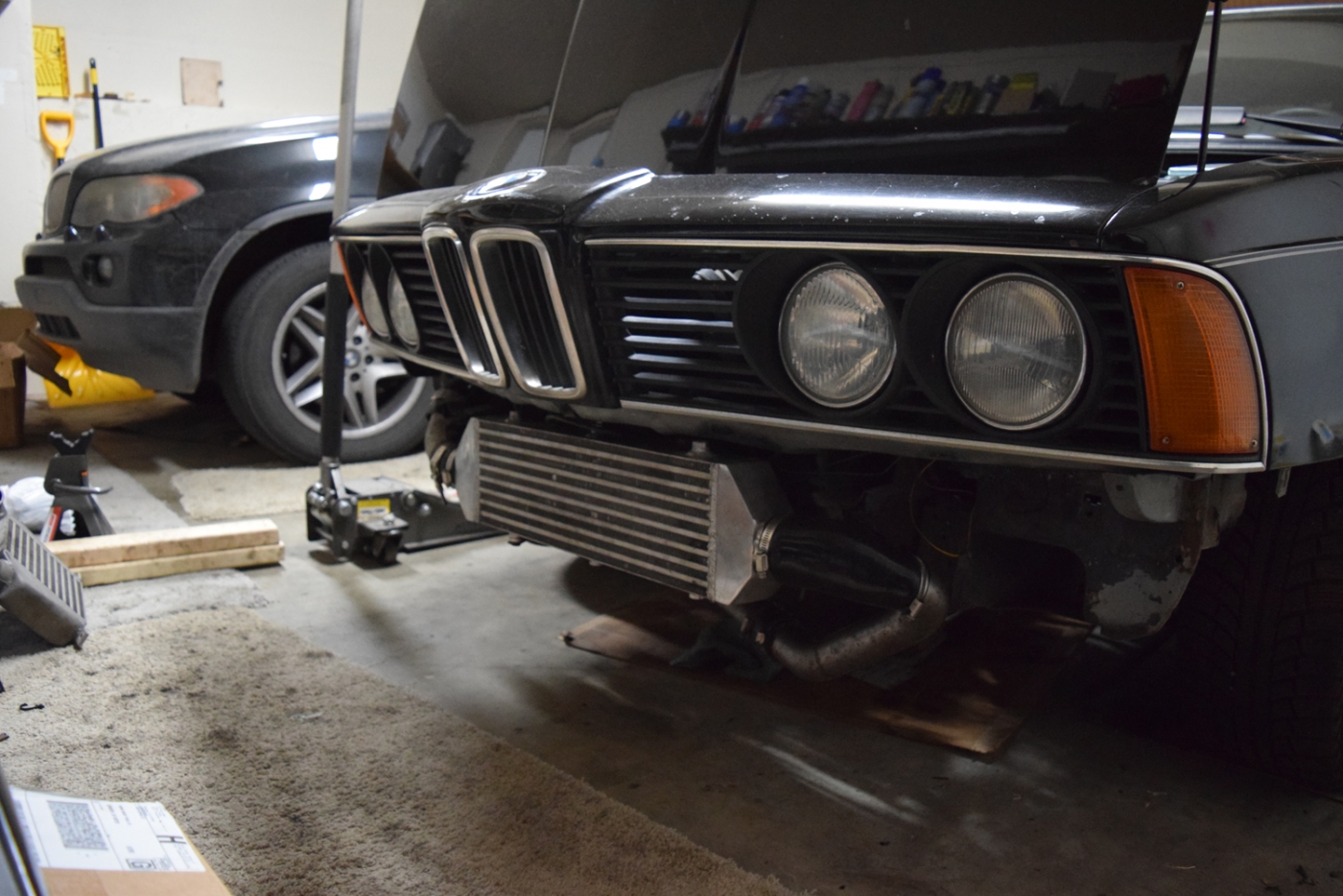
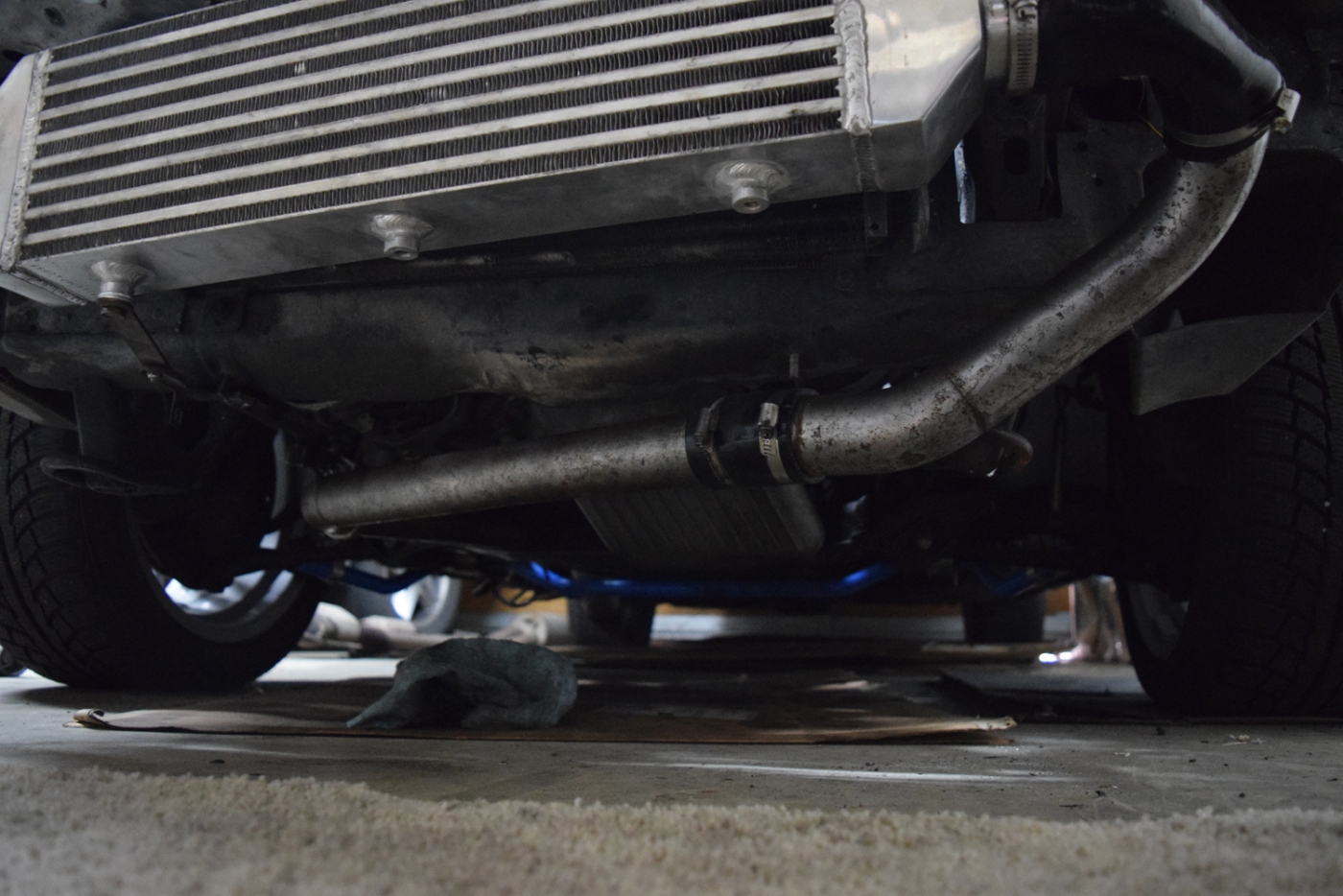
The #5 upper exhaust nut was difficult, but doable to tighten. Hopefully I don't have to remove this setup for quite a while!
Here's the intercooler and old piping. The bend on the right is different now and may change when I play with it in the next few days.


Re: 633CSi Turbo - 12/22/2017 - Not Really Callaway Anymore
Seems like it would be easier to route the cold side of the charge pipe up the drivers side. Either reverse mount the throttle or run a 180deg bend off the throttle in the stock location.
Re: 633CSi Turbo - 12/22/2017 - Not Really Callaway Anymore
I was thinking about this actually... I would have to rework my icv and divertor valve but was going to investigate. so I may run non intercooled until I think about it some more. ill look at routing the charge piping both ways before I decide
Re: 633CSi Turbo - 12/22/2017 - Not Really Callaway Anymore
Since you're running MAP you can run the diverter/blowoff anywhere between the turbo and throttle. There's no need to recirculate it - although it can be a little louder when dumping to atmosphere.
By the looks of it you could probably also leave the ICV in the same location and just weld on a 1" (maybe its 7/8", I can't remember) bung.
That would clear up a couple feet of piping.
By the looks of it you could probably also leave the ICV in the same location and just weld on a 1" (maybe its 7/8", I can't remember) bung.
That would clear up a couple feet of piping.
Re: 633CSi Turbo - 12/22/2017 - Not Really Callaway Anymore
Great job Tom. My experience has been that using the b35 cam does result in a 4-500rpm shift int he curve but doesn't make the car accelerate faster.
Re: 633CSi Turbo - 12/22/2017 - Not Really Callaway Anymore
I'm assuming you'd also need the bump in compression to take advantage of the different cam profile.T_C_D wrote:Great job Tom. My experience has been that using the b35 cam does result in a 4-500rpm shift int he curve but doesn't make the car accelerate faster.
Re: 633CSi Turbo - 12/22/2017 - Not Really Callaway Anymore
Thanks for the comments guys.
For the cam, I had to replace it anyway, so why not get one with more lift? I figure the cam will help the engine breathe as far as getting the charge in and out to the turbine. I was going off of a post by Paul Burke suggesting that the B35 cam is probably the best available for turbo (besides his custom grind and others, $$$).
With the torque curve shifted up slightly, I think I will be able to better use the torque at the track.
Last night I wired the TPS and started it up and came into a smooth idle! I need to work on readjusting my exhaust to be able to get an o2 signal, but it is coming along. I am thinking the signal noise is gone but need to look at it a bit more to tell for sure.
For the cam, I had to replace it anyway, so why not get one with more lift? I figure the cam will help the engine breathe as far as getting the charge in and out to the turbine. I was going off of a post by Paul Burke suggesting that the B35 cam is probably the best available for turbo (besides his custom grind and others, $$$).
With the torque curve shifted up slightly, I think I will be able to better use the torque at the track.
Last night I wired the TPS and started it up and came into a smooth idle! I need to work on readjusting my exhaust to be able to get an o2 signal, but it is coming along. I am thinking the signal noise is gone but need to look at it a bit more to tell for sure.
Re: 633CSi Turbo - 12/22/2017 - Not Really Callaway Anymore
Unfortunately PB has never owned a turbo m30 personally nor tested any cams for that application. You will be fine. You just have to gear the car accordingly.tschultz wrote:Thanks for the comments guys.
For the cam, I had to replace it anyway, so why not get one with more lift? I figure the cam will help the engine breathe as far as getting the charge in and out to the turbine. I was going off of a post by Paul Burke suggesting that the B35 cam is probably the best available for turbo (besides his custom grind and others, $$$).
With the torque curve shifted up slightly, I think I will be able to better use the torque at the track.
-
downforce22
- Posts: 66
- Joined: Apr 06, 2015 9:24 PM
- Location: colorado springs
Re: 633CSi Turbo - 12/22/2017 - Not Really Callaway Anymore
Since you may have to revisit your tune, this link has some useful information. I'll copy it in case the website goes down, but the image was useful to see fuel consumption vs BMEP, or max power.
http://ackthud.com/shawnfogg/mixture.htm
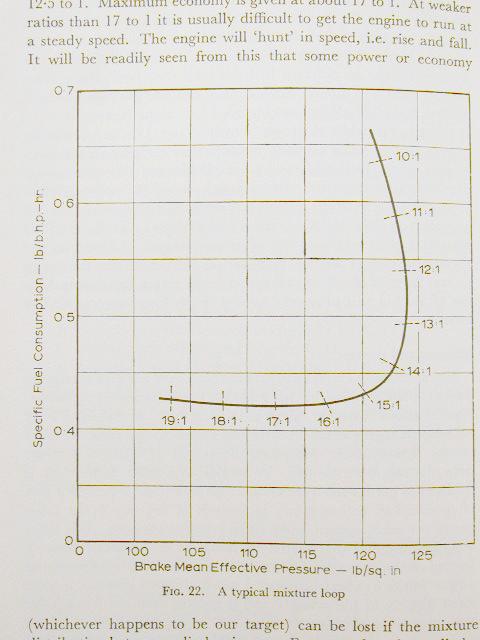
http://ackthud.com/shawnfogg/mixture.htm

So even running at 11:1 doesn't lose much power as compared to max power at 12.8:1For the most complete combustion gasoline usually needs to be burned at a ratio of 14.7 parts of air to 1 part fuel. This air to fuel ratio (AFR) is called stoichiometric or Lambda = 1. This is just a ratio between air and fuel. For example all of the following are at the same AFR:
7.35 lbs of air to 0.5 lbs of fuel
14.7 lbs of air to 1 lbs of fuel
147 lbs of air to 10 lbs of fuel
Obviously the amount of air and fuel being burned is totally different between each example but the AFR for each is identical.
14.7:1 AFR is normally considered the best trade off between emissions, fuel economy and power production.
Running LEAN is when your AFR has more air to it. The AFR is greater then 14.7:1 (Lambda >1) for example 16:1 AFR is lean. Running lean increases emissions, increases heat, usually increases fuel economy, reduces power and increases the chances of knocking.
Running RICH is when your AFR has more fuel to it. The AFR is less then 14.7:1 (Lambda <1) for example 13:1 AFR is rich. Running rich increases emissions, usually decreases heat, decreases fuel economy, increases power (to a point), decreases the chance of knocking. Running rich for long periods of time can cause deposits to build up on the plugs and O2 sensors (fouling) and can clog your catalytic converter. Maximum power is usually obtained running around a 12.3:1 AFR. Going richer then that will cost a little power but you loose less power then being leaner then 12.3:1. This can be seen in the graph below.
The above graph is taken from 'The Sports Car Engine: Its Tuning and Modification' by Colin Campbell. The graph shows basically how much pressure is created by burning gasoline at different AFRs and also how much fuel is consumed in doing so. Highest power will be achieved at highest pressure (most force pushing on your pistons).
When you are cruising and idling (the emissions cycle) the DME uses your oxygen sensors ( O2 sensors) to determine what AFR the engine is running at. The O2 sensors sense how much O2 is in the exhaust and send a voltage signal to the DME to give the mixture. Different manufacturers of O2 sensors send different voltage signals to the DMEs they are used with. However the DMEs logic behind the O2 sensor data is the same.
Re: 633CSi Turbo - 12/22/2017 - Not Really Callaway Anymore
Good information-- that is a good plot to have to understand the affect of AFR on power. I did notice the power drop off on track when I ran the BEGI RRFPR and ratios hit 10.5:1.
Good news. I got the car started and the exhaust was able to fit up after some adjustment.
Here's a short video before I had the downpipe and wastegate dump fully sealed. There is not intercooler, as you can see from the video-- I am running it this way until I rethink piping.
https://www.youtube.com/watch?v=z3yKg8rsC4k
I drove it today and seem to have much better signals than with the old wire harness. I will do more test drives and video as the weather warms up. 15F and my thick engine oil didn't get along real well for the test drive.
Here's a sample idling after the test drive around the block:
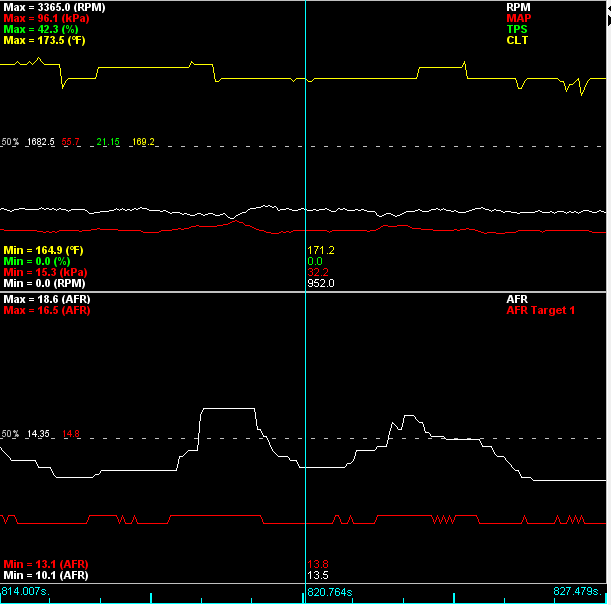
And my current spark/VE tables after a very brief autotune
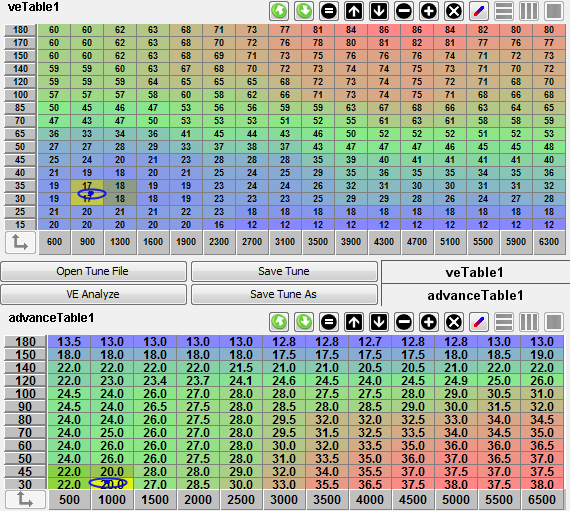
Pictures and videos to come!
Good news. I got the car started and the exhaust was able to fit up after some adjustment.
Here's a short video before I had the downpipe and wastegate dump fully sealed. There is not intercooler, as you can see from the video-- I am running it this way until I rethink piping.
https://www.youtube.com/watch?v=z3yKg8rsC4k
I drove it today and seem to have much better signals than with the old wire harness. I will do more test drives and video as the weather warms up. 15F and my thick engine oil didn't get along real well for the test drive.
Here's a sample idling after the test drive around the block:
And my current spark/VE tables after a very brief autotune
Pictures and videos to come!

